IN
SEARCH OF UTOPIA
A
holistic movement for a better world
has been evolving throughout history...
Human
history has been recorded as a succession
of wars and changing empires. But a ray
of hope has been carried forth throughout
the ages by dreamers who have envisioned
a more peaceful, just and sustainable world.
The Magna Carta, The US Constitution, and
The UN Declaration of Human Rights were
significant milestones and quantum leaps
forward in our collective quest for a better
world. We still have far to go, but we can
help create that better world countless
dreamers have imagined, wished for, and
endeavored to make come true. Every moment
has brought us to this moment. We are the
ones we've been waiting for to manifest
our shared Peacetopian Dream.
6th
Century BC
"Tao Te Ching"
|
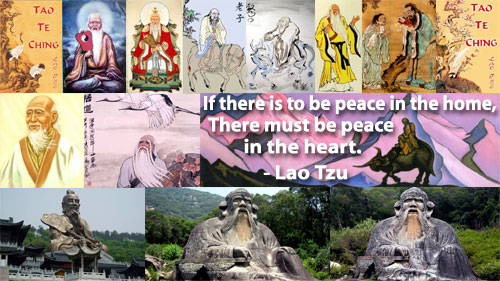
"If
there is to be peace in the world,
There must be peace in the nations.
If there is to be peace in the nations,
There must be peace in the cities.
If there is to be peace in the cities,
There must be peace between neighbors.
If there is to be peace between neighbors,
There must be peace in the home. If
there is to be peace in the home,
There must be peace in the heart."
- Lao Tzu
The
Tao Te Ching, the principle
text of Taoism, one of the major religions
of Asia, is said to have been written
by 6th Century BC Chinese philosopher
Lao Tzu. The basis of Taoism is to
live in harmony with the Tao (the
'way' or 'path') which is the root
of all things and the driving force
behind all of existence. According
to the Tao Te Ching, people
have free will and can change their
nature and behavior. When we return
to our natural state of being in harmony
with the Tao, we gain power and can
solve our own problems and the problems
of the world.
|
5th
Century BC
"Five Classics"
|
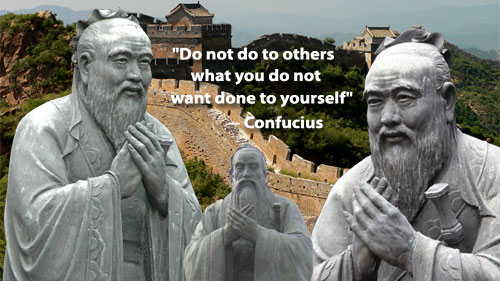
"When
the perfect order prevails, the world
is like a home shared by all. Leaders
are capable and virtuous. Everyone
loves and respects their own parents
and children as well as the parents
and children of others. The old are
cared for, adults have jobs, children
are nourished and educated...Everyone
has an appropriate role to play in
the family and society..." -
Confucius
Confucius
was a Chinese philosopher and politician
whose teachings greatly influenced
life throughout many periods of Chinese
and other Asian country's history
through the Ages. Confucianism, the
ethical system developed from his
teachings, is based in humanism, with
the idea that this world, and in particular
family and community, should be the
focus of one's spiritual pursuits.
Through self-cultivation and shared
communal activities, humans can learn
to improve and become better people.
The most important values in his philosophy
are justice, sincerity, personal and
governmental morality, and right relationships
between all people, which he summed
up in an early version of the Golden
Rule as "Do not do to others
what you do not want done to yourself."
|
c.
380 BC -
"Republic"
|
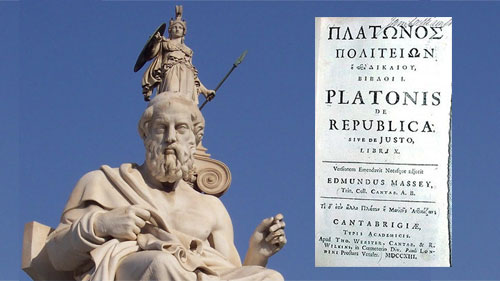
Greek
philosopher Plato wrote the first
known utopian proposal in his most
famous work, Republic. Through
dialogues and fictional prose, he
described how to create an ideal peaceful
city-state, where justice reigned
and there was no hunger or poverty.
(more)
|
1215
-
The Magna Carta
|
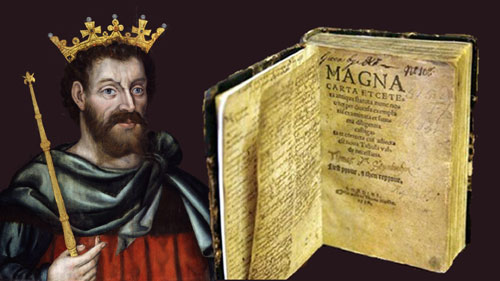
The
Magna Carta ("Great
Charter" in Latin) was one of
the first documents in the Western
World that proclaimed the rights of
the individual, and declared that
the King was bound by laws that were
fixed and not arbitrary.
(More)
|
1516
-
"Utopia"
|
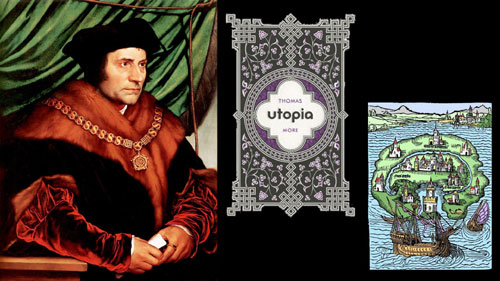
In
the early 16th century, Sir Thomas
More described an imaginary island
called Utopia, whose inhabitants
lived in a much more sustainable and
egalitarian society than those which
existed in Europe at the time. His
ideas inspired centuries of Utopian
literature, and his work presented
concepts in political, religious and
social thought that greatly influenced
future theorists, philosophers and
political organizers.
(More)
|
1528
-
"On Civil Power"
|
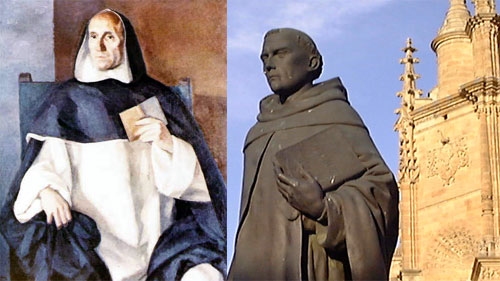
Francisco
de Vitoria was a Jewish-born Spanish
Renaissance Roman Catholic legal philosopher,
scholar and theologian who is sometimes
dubbed 'the father of international
law', although the actual concept
of international law wasn't
developed until many years later.
He has also been called the "founder
of global political philosophy" because
of his description of a 'republic
of the whole world.' His lectures,
like On Civil Power (De
potestate civili) written in 1528,
were never published during his lifetime,
but his ideas had a profound impact
on the paradigm-shifting movements
that arose over the next two centuries.
|
1568
-
Edict of Torda (Patent of Toleration)
|
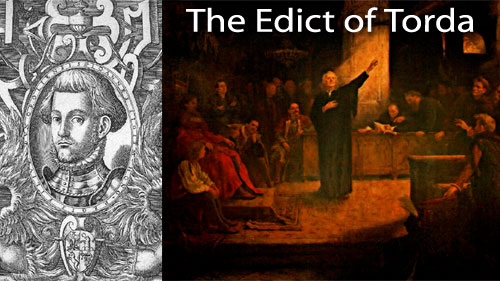
After
the Protestant Reformation in the
early 1500s, European countries began
establishing national churches, declaring
a single religion as the official
state religion, and restricting the
freedoms of all other faiths. One
of the early attempts to guarantee
religious freedoms in Europe was the
Edict of Torda, or Patent
of Toleration, proclaimed in 1568
by King John Sigismund Zápolya (János
Zsigmond Zápolya), the King of Hungary
and the first ruler of Transylvania.
Under the advice of his Unitarian
Minister Ferenc Dávid, King Sigismund
decided not to establish a state religion
in Hungary, but instead promoted religious
tolerance.
|
1589
-
"Law of War"
|
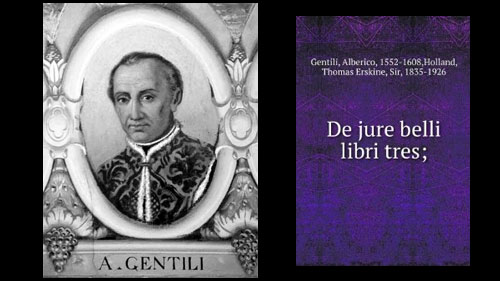
Alberico
Gentili was an Italian lawyer and
legal scholar living in England who
was one of the first to write about
the concept of international law.
His first work dealing with international
law was published in 1582 and his
major work on the legal guidelines
for war was published in 1589. Although
his international fame was eclipsed
by the 1625 publication of Dutch legal
philosopher Hugo Grotius' book, On
The Law of War and Peace, Grotius'
work was largely influenced by Gentili.
It wasn't until the mid 1800s that
Gentili's groundbreaking ideas were
rediscovered by international law
scholars.
|
1625
-
"On The Law of War and Peace"
|
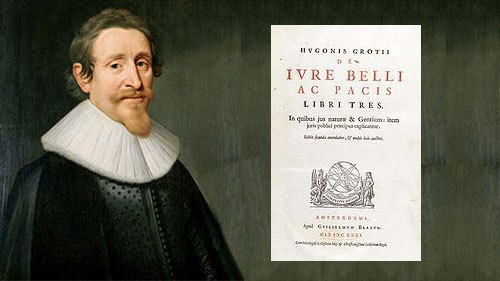
Hugo
Grotius (Hugo de Groot) was a Dutch
legal philosopher, poet and theologian
whose 1625 book, On The Law of
War and Peace (De Jure Belli
ac Pacis) helped lay the foundation
for the idea of international law
based on the "natural principles of
justice." This idea that there are
universal and objective standards
for justice would later come to be
known as 'natural law' and would become
the impetus for the Age of Enlightenment
and the widespread revolutionary movements
for the establishment of democratic
governments based on universal rights
and the will of the people.
|
1648
-
Peace of Westphalia
|
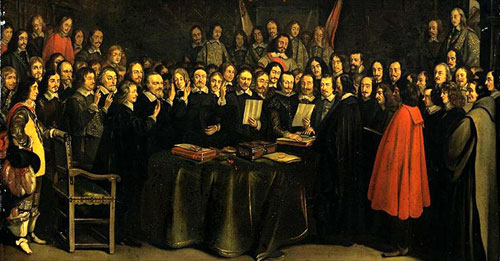
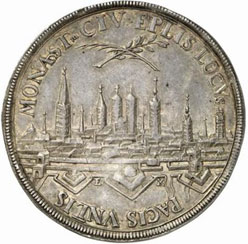 War
has been a problem that has plagued
humanity throughout the ages. One
important concept that arose to address
the constant fear of having to be
vigilantly prepared for war, was for
states to form alliances and agreements
that would provide 'collective security.'
Smaller alliances were common throughout
history, but in 1629, French Catholic
Cardinal Richelieu proposed a plan
for collective security on a much
larger scale. His proposal was partially
realized in 1648 with the Peace of
Westphalia, a series of peace treaties
that ended several major ongoing wars. War
has been a problem that has plagued
humanity throughout the ages. One
important concept that arose to address
the constant fear of having to be
vigilantly prepared for war, was for
states to form alliances and agreements
that would provide 'collective security.'
Smaller alliances were common throughout
history, but in 1629, French Catholic
Cardinal Richelieu proposed a plan
for collective security on a much
larger scale. His proposal was partially
realized in 1648 with the Peace of
Westphalia, a series of peace treaties
that ended several major ongoing wars.
(More)
|
1650-1799
-
Age of Enlightenment / Age of Reason
|
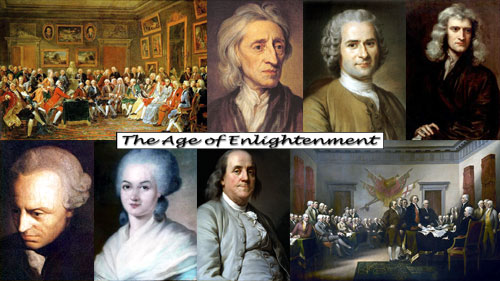
In
the 17th and 18th centuries, a movement
called the Age of Reason or
Age of Enlightenment swept
across Europe and the American colonies,
changing the existing paradigm by
providing a new perspective on the
nature of the universe and humanity's
place in it. Philosophers, scientists,
playwrights and other intellectuals
challenged the pervading mindset of
the time that was grounded in religious
faith and tradition, and instead argued
that reason - logical knowledge obtained
through a method of scientific inquiry
-- should guide one's individual behavior
and be the foundation of society's
laws and institutions.
(More)
|
1689
-
"Two Treatises of Government"
|
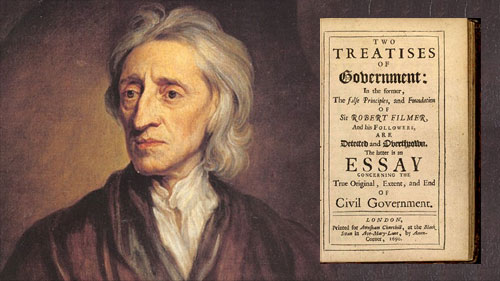
John
Locke was an English physician and
philosopher whose reputation as one
of the most influential thinkers of
the Enlightenment earned him the distinction
of being regarded as the Father of
Classical Liberalism. His thoughts
on political philosophy influenced
many of the proponents of the Age
of Enlightenment in Europe as well
as the American Revolutionaries, and
can be seen in the United States Declaration
of Independence and other significant
milestone documents. In the second
part of his monumental work, Two Treatises
of Government, Locke developed his
ideas of "natural rights" and the
"social contract" as the foundation
and justification for his outline
of a just and civilized society. Locke
proposed that the true 'law of nature'
is that all people are born equal,
free and independent, and everyone
has the natural right to defend their
life, liberty, health and possessions.
(More)
|
1762
-
"The Social Contract"
|
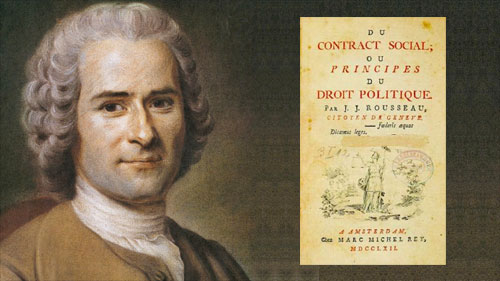
Jean-Jacques
Rousseau's monumental work, Of
The Social Contract, Or Principles
of Political Right (Du contrat social
ou Principes du droit politique)
built on ideas of political philosophers
like John Locke to more clearly define
the ideals of the Enlightenment. Rousseau
begins with the assertion that everyone
is born free, but in order to exist
peacefully, we enter into a 'social
contract', whereby each person gives
up the same amount of rights and freedoms
and takes on the same amount of responsibilities
by abiding by a set of laws. The ideals
of the Enlightenment inspired the
wave of reform and revolution that
spread across Europe and the American
colonies.
(More)
|
July
4, 1776 -
United States Declaration of Independence
|
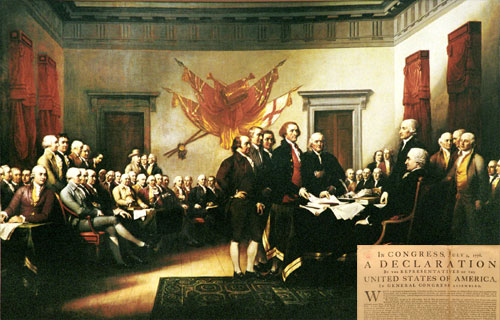
"We hold
these truths to be self-evident,
that all men are created equal,
that they are endowed by their Creator
with certain unalienable Rights,
that among these are Life, Liberty
and the pursuit of Happiness."
The
opening of the Preamble to the United
States Declaration of Independence
has been called "one of the best-known
sentences in the English language",
and for many historical figures, like
Abraham Lincoln and others throughout
the world, it represents the moral
standard that governments should strive
to live up to.
(More)
|
September
17, 1787-
United States Constitution
|
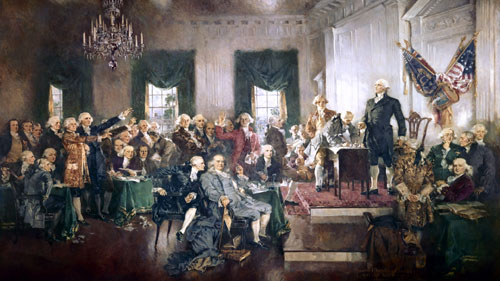
Constitutions
- a set of basic principles and
precedents by which a state, nation
or organization are governed -
have been used to organize societies
throughout history. They describe
the structure and laws that determine
how a government is organized, and
are an agreement between the citizens
and the rulers, ensuring that the
citizens will have specific rights
and responsibilities that the rulers
will honor and abide. The United States
Constitution, adopted on September
17, 1787 is significant in that it
is one of the first to begin with
the idea that the government represents
the will of the people.
(More)
|
August
26, 1789 -
Declaration of the Rights of Man and of
the Citizen
|
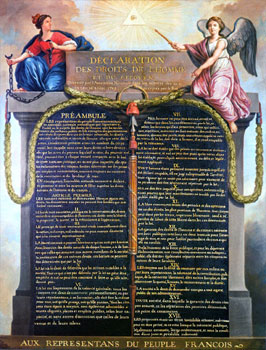 In
18th century French society, the aristocracy
had everything, including rights and
possessions, but the majority of the
population had barely enough to survive.
Influenced by the writings of the
philosophers of the Enlightenment,
many different groups in France, with
very different interests, joined together
to wage a "revolution of equality."
The
Declaration of the Rights of Man
and of the Citizen was the first
step in writing a new constitution,
and it codified the ideals of the
Enlightenment by enumerating the specific
natural rights to which all men, who
are born free, are entitled. In
18th century French society, the aristocracy
had everything, including rights and
possessions, but the majority of the
population had barely enough to survive.
Influenced by the writings of the
philosophers of the Enlightenment,
many different groups in France, with
very different interests, joined together
to wage a "revolution of equality."
The
Declaration of the Rights of Man
and of the Citizen was the first
step in writing a new constitution,
and it codified the ideals of the
Enlightenment by enumerating the specific
natural rights to which all men, who
are born free, are entitled.
(More)
|
September
25 , 1789 -
United States Bill of Rights
|
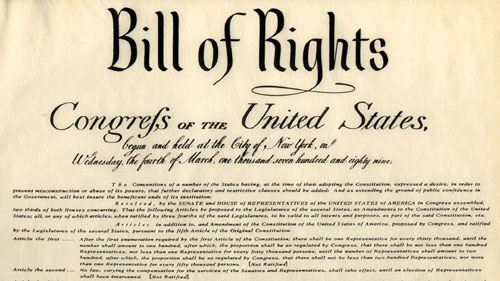
While
the US Constitution was being drafted,
some of the Founding Fathers were
concerned that it gave the new federal
government too much power. They feared
that it posed a threat to the rights
and freedom of individuals and surrendered
too much of the individual states'
authority. Some refused to sign it
until it was agreed that a Bill of
Rights would be added that would guarantee
all men's natural rights to freedom
and property, limit the government's
judicial power, and ensure the authority
of individual states in many matters.
(More)
|
1793
-
Proposal for a Department of Peace
|
 In 1793, Dr. Benjamin Rush, one of
the signers of the Declaration of
Independence, proposed the creation
of a Department of Peace to help establish
perpetual peace in the new nation.
Although his suggestion was not adopted,
the movement to create a department
with a Secretary of Peace continued
throughout US history. Bills calling
for the establishment of a Department
of Peace have been introduced in Congress
nearly 100 times!
In 1793, Dr. Benjamin Rush, one of
the signers of the Declaration of
Independence, proposed the creation
of a Department of Peace to help establish
perpetual peace in the new nation.
Although his suggestion was not adopted,
the movement to create a department
with a Secretary of Peace continued
throughout US history. Bills calling
for the establishment of a Department
of Peace have been introduced in Congress
nearly 100 times!
(more)
|
1795
"Perpetual Peace: A Philosophical
Sketch"
|
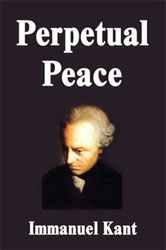 In
1795, German Philosopher Immanuel
Kant outlined the idea of a 'league
of nations' in his monumental work,
Perpetual Peace: A Philosophical
Sketch. He did not advocate creating
a single world government, but instead
proposed that all nations should be
free, respect their citizens' natural
rights, and welcome foreign visitors
as equal and fellow rational beings.
This would help control conflicts
and promote peace between countries,
thus creating a peaceful community
of nations. In
1795, German Philosopher Immanuel
Kant outlined the idea of a 'league
of nations' in his monumental work,
Perpetual Peace: A Philosophical
Sketch. He did not advocate creating
a single world government, but instead
proposed that all nations should be
free, respect their citizens' natural
rights, and welcome foreign visitors
as equal and fellow rational beings.
This would help control conflicts
and promote peace between countries,
thus creating a peaceful community
of nations.
(More)
|
1814
On the Reorganization of European Society
|

At
the beginning of the Industrial Age
in the early 1800s, life was difficult
for the working class. Simply to survive,
men, women and young children had
to work sixteen to eighteen hours
a day in terrible conditions. Education
opportunities were limited for the
poor and diseases were widespread.
At the same time, the wealthy class
lived a life of leisure and luxury.
It was under these conditions that
many began to question why these inequalities
existed. Several writers, who would
later come to be called 'utopian socialists',
were instrumental in exploring ideas
and arguments that would set the stage
for many theoretical and practical
applications of political and economic
philosophies and experiments. These
utopian socialists focused on envisioning
and designing ideal models for a better
society. Henri de Saint-Simon and
Charles Fourier in France, and Robert
Owen in Britain were the leading visionaries
of this new emerging movement. Saint-Simon,
the first of the Utopian Socialists,
believed that science should replace
religion in guiding society toward
a positive reorganization, without
exploitation of the individual members
of the society. He felt that a true
equality could be achieved by "a union
of men engaged in useful work." Saint-Simon
is often considered the father of
'sociology' - the study of societies,
and his many writings, such as his
1814 essay, On the Reorganization
of European Society, which predicted
the European Union, and several journals
which espoused his socialist ideas,
greatly influenced the socialist thinkers
and pragmatists that followed.
|
1815
Peace Societies
|
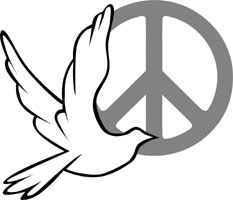 The
emergence of a paradigm-shifting holistic
movement for a more peaceful, just
and sustainable world has made great
strides thanks to a rich history of
organized peace movements. For as
long as there have been wars, there
have been those who have advocated
for peace. But in the last 2 centuries,
peace advocates have been more organized
and have created major local, national
and international movements for peace.
Modern peace movements can be traced
to the rise of Peace Societies throughout
Europe and America. Starting in 1815,
the first Peace Societies were created,
first in New York, then Ohio and Massachusetts
and in London in 1816, each without
knowing about the others! Historians
trace the impetus for the idea to
a tract entitled, "The Mediator's
Kingdom, not of this world, but Spiritual,"
published in 1809 by David Low Dodge,
a New York City merchant. Although
numerous wars took place during the
1800s and the 20th Century was the
bloodiest century in human history,
the peace movements continued to grow
and sound a voice of reason. It has
been the cry for peace that caused
the shifts in consciousness that led
to the creation of international bodies
for global cooperation like the League
of Nations and the United Nations,
and international laws that help create
the parameters and guidelines for
behavior for a more a more peaceful,
fair, just and equitable world. The
emergence of a paradigm-shifting holistic
movement for a more peaceful, just
and sustainable world has made great
strides thanks to a rich history of
organized peace movements. For as
long as there have been wars, there
have been those who have advocated
for peace. But in the last 2 centuries,
peace advocates have been more organized
and have created major local, national
and international movements for peace.
Modern peace movements can be traced
to the rise of Peace Societies throughout
Europe and America. Starting in 1815,
the first Peace Societies were created,
first in New York, then Ohio and Massachusetts
and in London in 1816, each without
knowing about the others! Historians
trace the impetus for the idea to
a tract entitled, "The Mediator's
Kingdom, not of this world, but Spiritual,"
published in 1809 by David Low Dodge,
a New York City merchant. Although
numerous wars took place during the
1800s and the 20th Century was the
bloodiest century in human history,
the peace movements continued to grow
and sound a voice of reason. It has
been the cry for peace that caused
the shifts in consciousness that led
to the creation of international bodies
for global cooperation like the League
of Nations and the United Nations,
and international laws that help create
the parameters and guidelines for
behavior for a more a more peaceful,
fair, just and equitable world.
|
April
27, 1825
New Harmony
|
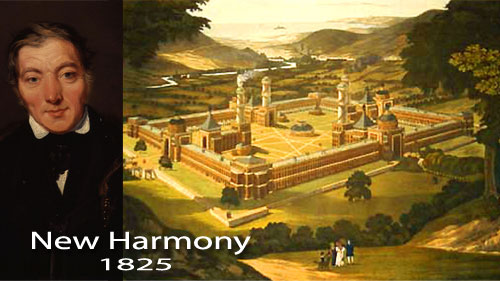
On
April 27, 1825, successful British
industrialist Robert Owen, established
a utopian community in the town of
New Harmony, Indiana he had just purchased.
This was one of the first intentional
communities established to be organized
around the principle of rational ethics
instead of religion. Owen believed
that misery and vice in the world
stemmed from a "trinity of evils"
: traditional religion, inequalities
in wealth and private property, and
conventional marriage based on religion
and property. He also thought that
through education and nurturing a
person's intellect and spirit, human
character and potential could be developed
to its highest potential and benefit
for the individual and the community.
800 people were invited to live for
free in his egalitarian, utopian experiment.
Although the community proved to be
an economic failure after just two
years, Owen's experiment provided
inspiration for many philosophers
and political pragmatists and in the
development of what would eventually
become the principles and practices
of socialism.
More
|
1836
New Moral World
|
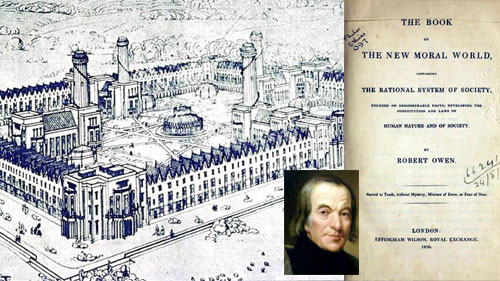
After
Robert Owen established a successful
cooperative cotton factory in Scotland
in the early 1800s proving that a
business venture could be financially
successful and humane to its workers,
and launched his experimental utopian
community in New Harmony, Indiana
from 1825-1827, he returned to Britain
and continued promoting his 'New Moral
World' utopian ideas for a more egalitarian
society. Owen was one of the first
to use the word 'socialism' to describe
the philosophy of mutually-owned and
operated working and living communities
he was promoting. He and his followers
set up gathering places called 'Halls
of Science' for non-religious meetings
and lectures, where participants communed
and sang 'socialist' hymns together.
Many early socialist writers and thinkers
contributed to a weekly periodical
called New Moral World that
Owen published. One of the contributors
and members of Owen's gatherings was
a young German journalist named Friedrich
Engels, who would later collaborate
with Karl Marx to lay the foundation
for one of the world's major political
and economic systems. In 1836, Robert
Owen outlined his ideas in The
Book of The New Moral World "containing
the rational system of society, founded
on demonstrable facts, developing
the constitution and laws of human
nature and of society."
|
1843
International Peace Congress
|
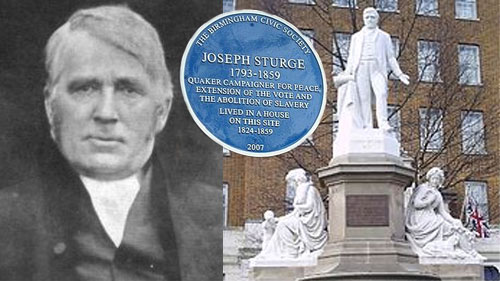
Today
social media has made the possibility
of organizing for true paradigm-shifting
transformation for a better world
more possible than ever. One of the
most powerful previous vehicles for
change was the advent of global forums
that brought activists together for
a shared mission from distant places
around the world. In 1843, the International
Peace Congress was a milestone event
in the rise of global forums. At the
suggestion of British Quaker, abolitionist
and worker's rights activist Joseph
Sturge, a series of international
meetings of representatives from peace
societies throughout the world took
place in various locations throughout
Europe, starting in London in 1843.
By sharing their experiences of successes
and failures and coordinating their
activities, the global peace movement
and the individual peace societies
themselves were able to be more efficient
and effective in their work.
|
1849
"Civil Disobedience"
|
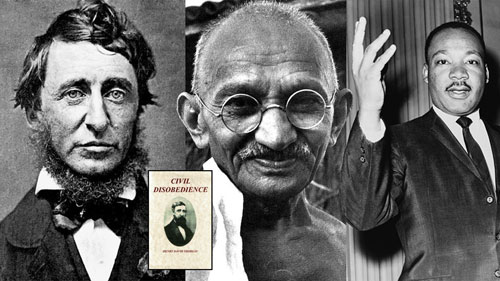
Henry
David Thoreau was one of the first
to define and use 'civil disobedience'
as a means of nonviolent protest.
His essay, Civil Disobedience,
was published in 1849, and the ideas
he expressed have had a profound influence
on nearly every nonviolent movement
for change since. Gandhi credited
Thoreau in helping inspire the ideas
and tactics he utilized in the movement
of nonviolent resistance that he led
to win independence for India in 1947.
Martin Luther King, Jr. read Thoreau's
essay at college and "became convinced
then that non-cooperation with evil
is as much a moral obligation as cooperation
with good." By building on Thoreau's
ideas, Gandhi and King showed that
civil disobedience was an effective
tool to raise awareness and bring
about change. Today many diverse movements
for a better world continue to use
the language and techniques of nonviolent
direct action that Thoreau wrote about.
|
February
1, 1865
13th Amendment Abolishing Slavery
|
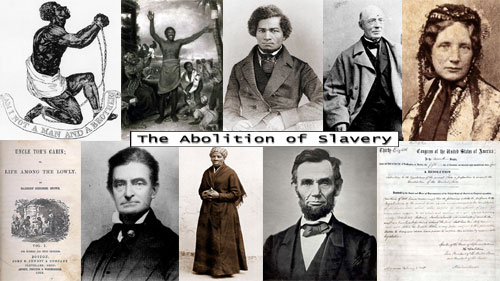
The
acceptance of the concept of slavery
- the idea of one person 'owning'
another - is one of the most obvious
hurdles that had to be overcome in
the pursuit of creating a better world.
Unbelievably, slavery was only outlawed
in the United States a century and
a half ago, and the journey towards
the abolition of slavery was a slow
and difficult victory fought by many
over many years. In the late 18th
century the call for an end to slavery
became very widespread, although colonies
and new nations that arose, like America,
where slavery was established, continued
to use slaves. In 1833, Britain abolished
slavery throughout the British Empire;
France did the same in 1848; and the
13th Amendment to the US Constitution
abolished slavery in the United States
in 1865 after a bloody civil war that
was somewhat fought over this issue.
Fortunately, human consciousness has
evolved so that slavery is almost
universally seen as a grave injustice,
and it is illegal almost everywhere
on earth. However, we still have more
to do to banish this violation of
freedom, because slavery still exists
today in the form of human trafficking
for labor and sexual bondage.
More
|
1879
"Progress and Poverty"
|
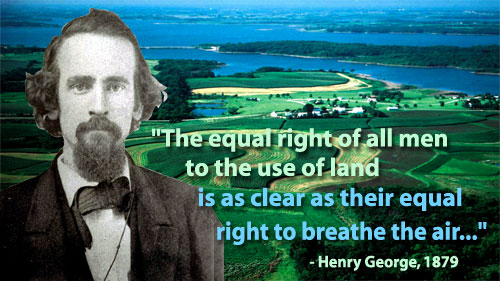
The
equal right of all men to the use
of land is as clear as their equal
right to breathe the air — it is a
right proclaimed by the fact of their
existence. For we cannot suppose that
some men have a right to be in this
world, and others no right.” -
Henry George
Today
there is growing interest in the "global
commons movement" which directly challenges
the current trend toward privatization
of social services and community resources.
Instead it presents the idea that
resources that people need to survive,
like air, water and land, and the
infrastructure that allows society
to function, should be shared by all.
Many also feel that the commons should
include our shared cultural heritage
- sites of historical significance
as well as art, music and literature.
The idea of seeing our shared assets
as part of the commons is certainly
not new, and a number of historical
movements around this idea have arisen
throughout history. Nineteenth-century
political economist Henry George was
a popular writer and speaker who inspired
an economic philosophy called Georgism,
rooted in the idea that all people
who live in a country collectively
own the land of that country. He was
a strong believer in private ownership,
but only of things that people create.
Citizens should be allowed to have
'private occupancy' of land, but they
would only be renting the land from
the community to use. In his most
famous work, Progress and Poverty,
Henry George discussed the inequality
inherent in the pervading economic
system, and detailed the economic
principles in his idea of a "single
tax" on land that would do away with
all other taxes, and keep ownership
of land in the hands of the community
for future generations.
|
May
18, 1899 -
Hague Peace Conference
|
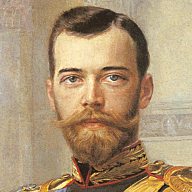 In
19th century Europe, nationalistic
tensions, combined with economic inequalities
brought about by the Industrial Revolution,
and military advancements like the
invention of dynamite and more efficient
killing machines capable of causing
more horrific and widespread destruction,
set the stage for a war mentality
that led to a growing arms race between
nations. In
1899, Russian Tsar Nicholas II invited
the leaders of Europe to meet in The
Netherlands at The Hague to discuss
disarmament, international laws that
would help to limit wars between nations,
and the establishment of an international
court to settle disputes peacefully. In
19th century Europe, nationalistic
tensions, combined with economic inequalities
brought about by the Industrial Revolution,
and military advancements like the
invention of dynamite and more efficient
killing machines capable of causing
more horrific and widespread destruction,
set the stage for a war mentality
that led to a growing arms race between
nations. In
1899, Russian Tsar Nicholas II invited
the leaders of Europe to meet in The
Netherlands at The Hague to discuss
disarmament, international laws that
would help to limit wars between nations,
and the establishment of an international
court to settle disputes peacefully.
(More)
|
1901
-
Nobel Peace Prize
|
 For
over a century, the Nobel Peace Prize
has been thought of as the highest
honor that can be bestowed upon a
person who has dedicated their life
to creating a more peaceful, just
and sustainable world. Ironically,
the Prize and the large cash award
that comes with it, were made possible
because of Alfred Nobel's invention
of the deadly explosives, dynamite
and ballistite in the mid-1800s. For
over a century, the Nobel Peace Prize
has been thought of as the highest
honor that can be bestowed upon a
person who has dedicated their life
to creating a more peaceful, just
and sustainable world. Ironically,
the Prize and the large cash award
that comes with it, were made possible
because of Alfred Nobel's invention
of the deadly explosives, dynamite
and ballistite in the mid-1800s.
(More)
|
1906-1914
"Satyagraha"
|
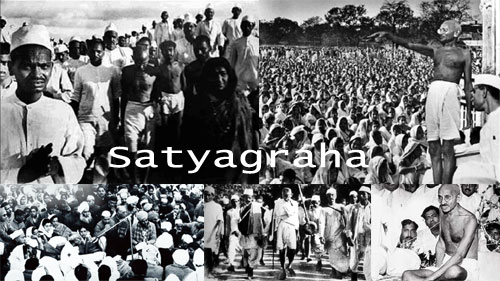
Mohandas
Gandhi is an iconic figure revered
for profoundly proving that nonviolent
action is a powerful force for change.
While working as a lawyer in South
Africa, Gandhi became politically
involved in defending the rights of
the oppressed Indian minority population
living and working there. Influenced
by the idea of 'natural rights' described
by the writers of the Enlightenment,
Henry David Thoreau's ideas of 'civil
disobedience' and the idea of 'passive
resistance' urged by others before
him, Gandhi coined the term 'satyagraha'
to describe the type of nonviolent
resistance he developed as he organized
massive strikes, protests and other
forms of nonviolent noncooperation.
Using the practice of satyagraha,
Gandhi helped India gain its independence
from British rule. Gandhi's actions
and teachings greatly influenced many
other nonviolent struggles for a better
world, including Martin Luther King,
Jr.'s campaigns for civil rights,
Nelson Mandela's struggle under apartheid
in South Africa, and Cesar Chavez's
advocacy for worker's rights.
More
|
January
8, 1918 -
Fourteen Points
|
The
United States was very hesitant to
get involved when war broke out in
Europe in 1914, but after the Germans
sank 7 US merchant ships, the US entered
World War I in 1917. On January 8,
1918, President Woodrow Wilson delivered
a speech to a joint session of Congress
called the "Fourteen Points." The
speech laid out a policy of the benefits
and responsibilities that all signers
of a peace agreement would share.
Wilson's Fourteen Points was largely
the basis for Germany's call for an
armistice and peace negotiations in
October, 1918. President Wilson received
the Nobel Peace Prize in 1919, and
although the United States Congress
would not allow the US to join, the
League of Nations that President Wilson
described in the "Fourteen Points"
was created that year.
(More)
|
June
28, 1919 -
League of Nations
|
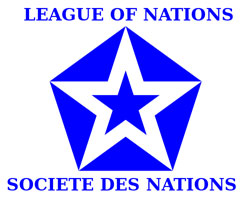 The
League of Nations was the first international
organization that was created for
the purpose of promoting world peace.
It was formed after the end of World
War I during the Paris Peace Conference,
with a wide-ranging set of goals,
including settling international disagreements
through arbitration and negotiation;
preventing wars through disarmament
and collective security; promoting
health and humanitarian relief; and
abolishing slave labor and illegal
drug trafficking. The
League of Nations was the first international
organization that was created for
the purpose of promoting world peace.
It was formed after the end of World
War I during the Paris Peace Conference,
with a wide-ranging set of goals,
including settling international disagreements
through arbitration and negotiation;
preventing wars through disarmament
and collective security; promoting
health and humanitarian relief; and
abolishing slave labor and illegal
drug trafficking.
(More)
|
1920
-
19th Amendment - Women's Right to Vote
|
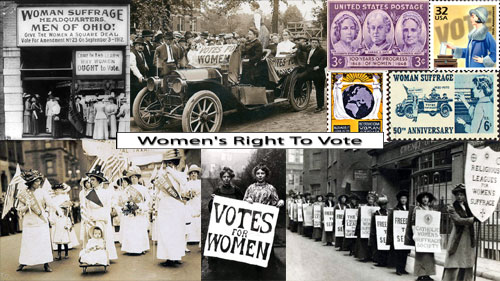
Even
though they make up half the population,
women and girls have endured discrimination
in most societies for thousands of
years. In the past, women were largely
treated as property of their husbands
or fathers - they couldn't own land,
they couldn't vote or go to school,
and were subject to beatings and abuse.
Over the last hundred years, much
progress has been made to gain equal
rights for women around the world,
but many still live without the rights
to which all people are entitled.
Gaining the right to vote and hold
a public office was a major milestone
in the struggle for women's rights.
The women's suffrage movement, which
secured these rights for women, can
be traced to France in the 1780s.
The French Revolution was inspired
by the writers of the Enlightenment
who spoke about the equality and natural
rights of all people -- men and women.
Although the French constitution that
was adopted did not grant women equal
rights, during the Revolution women
worked hand-in-hand with men with
an expectation of this ideal goal
in mind. Over the next 130 years,
movements arose all around the world
gaining limited victories, and finally
with the passage of the 19th Amendment,
women were granted the right to vote
in the United States in 1920.
more
|
1933
-
The New Deal
|
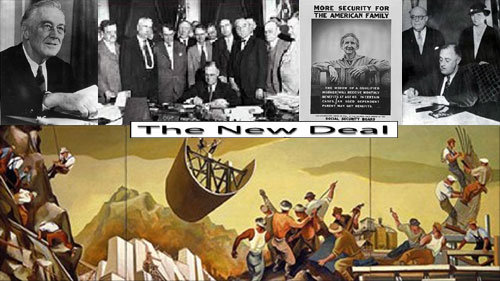
In
a utopian world, everyone would have
all they need for life, liberty and
the pursuit of happiness, and at least
the chance to achieve their hearts’
desires. In October, 1929, the Wall
Street Stock Market crashed, plunging
the United States into the worst economic
Depression in history. The widespread
devastation and suffering this caused,
illustrated the failure and lack of
utopian mission in the dominant institutions
of the day; clearly the governmental
infrastructure and the economic institutions
had not been acting in the best interests
of the majority of the people. The
nation was in desperate need of change,
and it came through the economic policies
of Franklin Delano Roosevelt’s “New
Deal.”
(More)
|
April
15 , 1935 -
The Roerich Pact - Pax Cultura
|
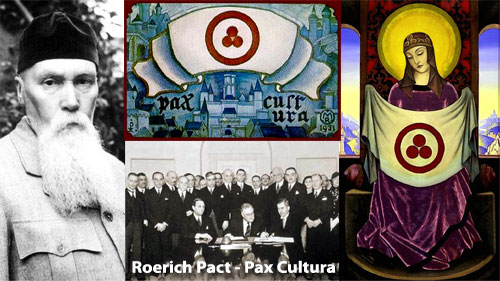
Russian
painter and philosopher Nicholas Roerich
designed the 'pax cultura' ('cultural
peace' or 'peace through culture')
symbol to express his belief that
humanity's future depended on preserving
our cultural heritage, and promoting
universal culture and spiritual development
of all people. He was successful in
bringing together the governments
of North, South and Central America
to agree to the protection of cultural
objects in times of war and peace,
with the signing of the Roerich Pact
on Protection of Artistic and Scientific
Institutions and Historic Monuments
at the White House in Washington DC
on April 15, 1935. Roerich based his
symbol on sacred origins, with the
three circles within a circle representing
'art' 'science' and 'religion' as
the expressions of human culture,
as well as the concept of the past,
present and future within the eternity
of time.
|
August
14, 1935 -
Social Security Act
|
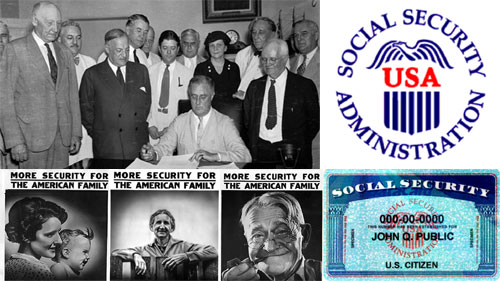
The
writers of The Enlightenment explored
the idea of a "social contract" between
society and the individual. If an
individual agrees to abide by the
laws the society imposes which restrict
a person's natural rights of freedom,
then society is morally obligated
to ensure that all members of the
society have all that they need to
live and at least the chance to pursue
a good life for themselves. After
the greed of the wealthy created the
Great Depression and caused widespread
hunger, poverty and suffering for
much of America, many felt that the
government should do more to create
a safety net so that no citizens should
be subjected to these injustices.
As part of the New Deal, President
Franklin D. Roosevelt's administration
set up many social programs to assist
people in all walks of life. Populations
most hurt by a troubled economy were
the elderly, disabled, and widows
with children, who did not necessarily
have a steady income to provide for
their family's needs. On August 14,
1935, President Roosevelt signed the
Social Security Act, a program that
is funded by a payroll tax on workers
and their employers, and continues
to this day to provide benefits to
retirees, the disabled, and to the
family's of deceased workers who have
paid into the system.
|
1938
-
Fair Labor Standards Act
|
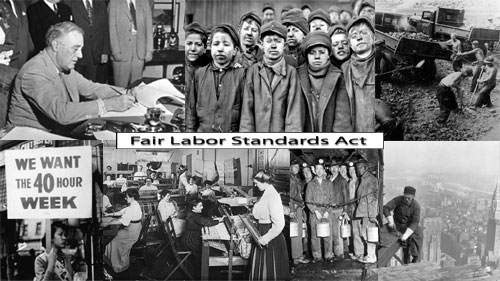
A
nation's well-being depends on those
who work to provide the goods and
services that allow its citizens to
lead productive and healthy lives.
Often throughout history, societies
have been divided into different classes,
with one class typically having to
do much of the work that keeps that
society running. Employers and governments
have not always treated the working
classes well - often workers had to
work long hours, in hazardous conditions
for little pay. The labor movement
arose in Europe during the Industrial
Revolution in the 18th and early 19th
centuries, beginning with working
people organizing into groups called
labor unions and trade unions. With
strength in numbers, workers had a
better chance to convince employers
and governments to treat them more
fairly. The movement met with great
resistance from the privileged classes.
But by the late 1800s it began to
grow into a worldwide movement, advocating
for reforms for the working class,
eventually leading to the elimination
of child labor, the right for workers
to organize into unions, to have shorter
work days and livable wages. A major
milestone was the 1938 passage of
the Fair Labor Standards Act as part
of the Roosevelt Administration's
New Deal policies. The Act established
a national minimum wage and 40 hour
work week, time and a half for overtime,
and prohibited oppressive child labor.
|
January
6 , 1941 -
The Four Freedoms
|
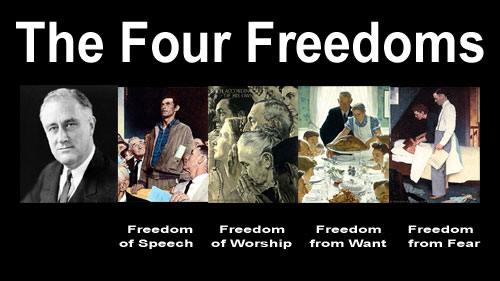
The
State of the Union address that President
Franklin Delano Roosevelt delivered
before the US Congress on January
6, 1941 is famously remembered as
the Four Freedoms speech. In
this speech, President Roosevelt outlined
four basic freedoms that everyone
in the world should enjoy: freedom
of speech; freedom of worship; freedom
from want; and freedom from fear.
(More)
|
October
24, 1945 -
The United Nations
|
 For
more than 65 years since its founding,
the United Nations has shone as humanity's
greatest hope for a more peaceful,
just and sustainable world. It has
helped to promote human rights, freedom
and democracy, erase poverty and hunger,
improve health and education, and
urge the governments of the world
to work together in peace. However,
the UN can only do what governments
allow it to do. Across the globe,
a people's movement has been growing
to convince governments to help the
UN in its goals, to reform the UN
by making it more democratic, and
to allow the UN to work more closely
with civil society in solving the
planet's problems. For
more than 65 years since its founding,
the United Nations has shone as humanity's
greatest hope for a more peaceful,
just and sustainable world. It has
helped to promote human rights, freedom
and democracy, erase poverty and hunger,
improve health and education, and
urge the governments of the world
to work together in peace. However,
the UN can only do what governments
allow it to do. Across the globe,
a people's movement has been growing
to convince governments to help the
UN in its goals, to reform the UN
by making it more democratic, and
to allow the UN to work more closely
with civil society in solving the
planet's problems.
(More)
|
August,
1947
World Federalist Movement
|
 The world has become an interconnected community with a growing number
of global problems. Because the United
Nations does not have the authority
to enforce many international laws
and treaties, and is not a democratically
elected body (and thus does not always
represent the will of all global citizens),
some believe the world needs a more
formalized form of democratic global
governance. World federalists
advocate for the creation of a democratically
elected world government with the
authority to make and enforce international
laws. In 1947, 51 world federalist
organizations from around the world
came together to unite their efforts. The world has become an interconnected community with a growing number
of global problems. Because the United
Nations does not have the authority
to enforce many international laws
and treaties, and is not a democratically
elected body (and thus does not always
represent the will of all global citizens),
some believe the world needs a more
formalized form of democratic global
governance. World federalists
advocate for the creation of a democratically
elected world government with the
authority to make and enforce international
laws. In 1947, 51 world federalist
organizations from around the world
came together to unite their efforts.
(More)
|
December
10, 1948 -
Universal Declaration of Human Rights
|
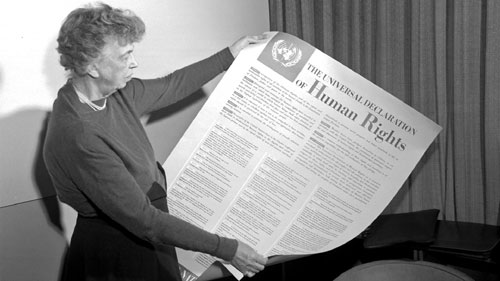
After
the horror of widespread, devastation,
suffering and genocide that ravaged
the world during World War II, there
was a general consensus that something
had to be done to make sure this kind
of gross violation of human rights
never took place again. Protecting
basic rights is essential in creating
a world at peace, and it was one of
the foundations of the goals of the
United Nations when it was created
in 1945. The UN Charter requires nations
to respect basic rights and freedoms
and to take action to protect them.
To
make it clear to nations what 'fundamental
freedoms' and 'human rights'
all people of the earth should be
guaranteed, the Universal Declaration
of Human Rights (UDHR) was adopted
by the United Nations General Assembly
on December 10, 1948. The UDHR is
now the most translated document in
the world, and it continues to provide
the moral and diplomatic framework
for those working for human rights
to bring about the changes needed
to create a better world.
(More)
|
1955-
"Let There Be Peace On Earth"
|
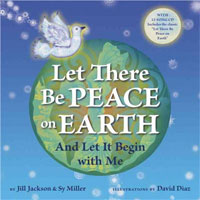 Husband
and wife song-writing team, Jill Jackson
and Sy Miller, first introduced their
song, Let There Be Peace On Earth
at a retreat with a group of multicultural
high school students. Sy Miller described
the occasion and the profound effect
it has had on millions around the
world since then: "'Let There
Be Peace on Earth, and Let It Begin
With Me' first born on a mountain
top in the voices of youth, continues
to travel heart to heart – gathering
in people everywhere who wish to become
a note in a song of understanding
and peace—peace for all mankind." Husband
and wife song-writing team, Jill Jackson
and Sy Miller, first introduced their
song, Let There Be Peace On Earth
at a retreat with a group of multicultural
high school students. Sy Miller described
the occasion and the profound effect
it has had on millions around the
world since then: "'Let There
Be Peace on Earth, and Let It Begin
With Me' first born on a mountain
top in the voices of youth, continues
to travel heart to heart – gathering
in people everywhere who wish to become
a note in a song of understanding
and peace—peace for all mankind."
(More)
|
1955
May Peace Prevail On Earth
|
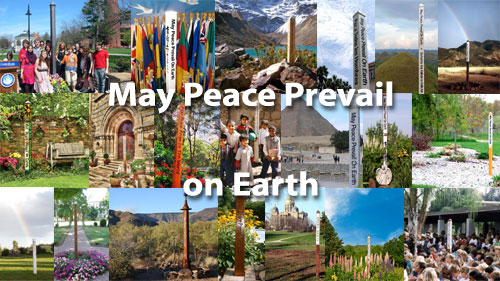
After
living through the horrors of World
War II, Masahisa Goi dedicated his
life to promoting peace. In Japan
in 1955, he began a worldwide Movement
of Prayer for World Peace based on
promoting the universal prayer of
peace, "May Peace Prevail On Earth."
He founded The Byakko Shinko Kai,
an association based on his spiritual
teachings, and The World Peace Prayer
Society which continues to promote
the message, "May Peace Prevail On
Earth," in every language. Today this
shared wish for a more peaceful, just
and sustainable world can be found
on nearly 200,000 peace poles in 180
countries.
(More)
|
July
9, 1955
"The Russell-Einstein Manifesto"
|
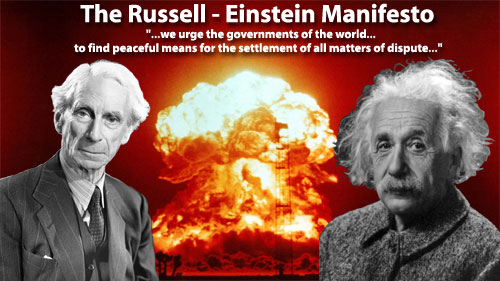
In
the midst of the Cold War, eleven
prominent scientists and intellectuals
issued a statement, called the Russell-Einstein
Manifesto, that warned governments
about the dangers of nuclear proliferation
and called for world leaders to work
together to find peaceful solutions
to international conflicts and disputes.
The signatories included ten Nobel
Prize winners, including economist
and philosopher Bertrand Russell who
led the initiative, and world-renown
scientist Albert Einstein, who signed
it only days before he died. Shortly
after the statement was issued, a
philanthropist agreed to fund an international
conference, which the Manifesto had
suggested should take place for scientists
to assess the urgent new dangers of
the nuclear age. This would turn out
to be the first of the Pugwash Conferences
on Science and World Affairs, and
the organization of the same name
that was formed went on to win the
Nobel Peace Prize in 1995 for its
continuing work for nuclear disarmament.
|
1956
The Beloved Community
|

One
of the goals that Martin Luther King,
Jr. promoted was the creation of the
'Beloved Community'. Dr. King envisioned
a global community of brotherhood
and sisterhood, where all are included
and treat each other without bigotry,
discrimination or racism. All people
will be seen as equals, and will share
in the abundance of the earth, so
that there will be no hunger, poverty
or homelessness. Everyone will be
educated with the tools and resources
to work out personal conflicts through
peaceful conflict resolution, and
nations will resolve international
disputes through the same nonviolent
means, instead of engaging in military
conflicts. Today,
Dr. King's concept of 'the beloved
community' is embraced at the very
heart of many organizations, including
The King Center, as well as by many
diverse faith-based groups and churches.
(More)
|
1960
- 1963
The New Frontier
|
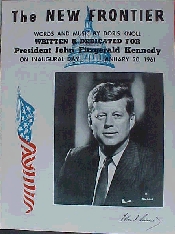 "…we
stand today on the edge of a New Frontier
… the frontier of unknown opportunities
and perils, the frontier of unfilled
hopes and unfilled dreams. ... Beyond
that frontier are uncharted areas
of science and space, unsolved problems
of peace and war, unconquered problems
of ignorance and prejudice, unanswered
questions of poverty and surplus…"
- John F. Kennedy, 1960 Democratic
National Convention acceptance speech "…we
stand today on the edge of a New Frontier
… the frontier of unknown opportunities
and perils, the frontier of unfilled
hopes and unfilled dreams. ... Beyond
that frontier are uncharted areas
of science and space, unsolved problems
of peace and war, unconquered problems
of ignorance and prejudice, unanswered
questions of poverty and surplus…"
- John F. Kennedy, 1960 Democratic
National Convention acceptance speech
When
John F. Kennedy accepted his party's
nomination as the Democratic Presidential
Candidate, he delivered a speech that
coined the expression, "New Frontier"
to describe the paradigm-changing
actions he would pursue to create
a more peaceful, just and sustainable
world, if he were elected. This hopeful
slogan became the banner for his administration's
domestic and foreign policies and
programs which aimed to eradicate
poverty, strengthen the nation's infrastructure
and reduce pollution, promote disarmament
and create a more peaceful and cooperative
global community, and accelerate the
space program to send a man to the
moon by the end of the decade. Under
the New Frontier, many major social
and economic reforms and achievements
were made. In fact, during the Kennedy
Administration, more new bills were
passed by Congress than at any other
time since the early 1930s.
|
March
1, 1961
United States Peace Corps
|
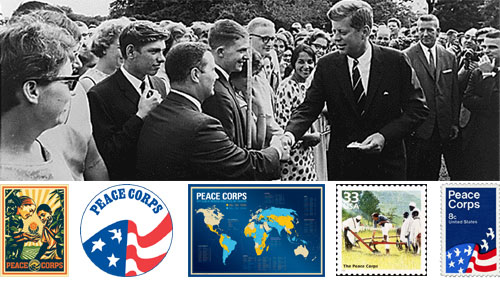
Much
of the efforts to make life better
for our communities and our world
are done by volunteers. Around the
world, hundreds of millions of people
volunteer - nearly 65 million volunteer
in America! Many volunteer organizations
are run through private and public
nonprofit organizations, and some
are coordinated through state and
national governments. Through service
to others in different cultures, volunteers
in the United States Peace Corps provide
hands-on expertise to assist in social
and economic development, help others
to understand American culture, and
learn about the cultures of other
countries themselves. President Kennedy
issued an Executive Order establishing
the Peace Corps on March 1, 1961,
and since then more than 210,000 American
Peace Corps volunteers have served
in 139 countries "to promote world
peace and friendship."
More
|
August
28, 1963
"I Have A Dream"
|

Martin
Luther King, Jr.'s "I Have a Dream"
speech has become a much-referenced
and beloved symbol of countless efforts
for a more peaceful, just and sustainable
world. Dr. King often spoke of 'dreams'
in his speeches, usually referring
to the gap between the ideals of the
'American Dream' and the reality that
most people, especially people of
color, faced. On August 28, 1963,
his "I Have a Dream" speech was the
centerpiece of the "March on Washington
for Jobs and Freedom" that brought
more than 250,000 civil rights supporters
to the steps of the Lincoln Memorial
in Washington DC. Coinciding with
the 100 year anniversary of the Emancipation
Proclamation that abolished slavery,
Dr. King inspired the crowd and countless
future generations with his vision
of fulfilling the American Dream to
truly create a land of freedom and
equality. This defining moment of
the Civil Rights Movement clearly
demonstrated the effective power of
amassing large numbers of supporters
for a cause of social significance.
The March helped put pressure on Congress
and the Kennedy Administration to
adopt important civil rights legislation,
and has and will continue to inspire
and empower numerous marches and protests
for other social causes.
|
1963
- 1969
The Great Society
|
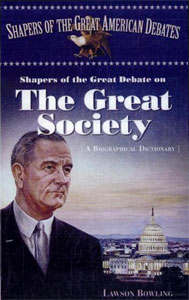 "And
with your courage and with your compassion
and your desire, we will build the
Great Society." - President Lyndon
Johnson on May 7, 1964 at Ohio University "And
with your courage and with your compassion
and your desire, we will build the
Great Society." - President Lyndon
Johnson on May 7, 1964 at Ohio University
Lyndon
B. Johnson became President after
the assassination of John F. Kennedy,
and when the Democrats won major landslide
victories in Congress in the 1964
election, President Johnson found
himself with the most liberal House
of Representatives since the 1930s.
He recognized the opportunity to revive
some of the liberal proposals his
predecessor had not been able to convince
Congress to pass, as well as to launch
even more ambitious plans to address
some of the major issues that faced
the nation in order to create a truly
'great society'. Under the banner
of "The Great Society", President
Johnson successfully promoted sweeping
domestic policy legislation that focused
on arts and culture, civil rights,
consumer protection, education, the
environment, medical care, poverty
and transportation. The next two Republican
Presidents, Richard Nixon and Gerald
Ford, continued to expand many of
the programs begun under the Great
Society agenda.
|
July
2, 1964
Civil Rights Act of 1964
|
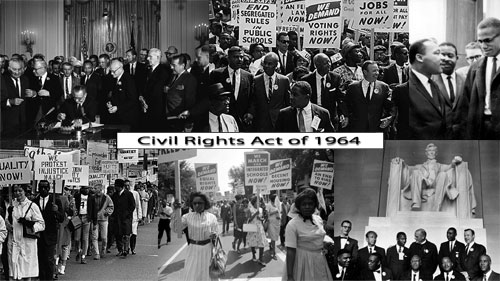
"Civil
Rights" are the rights and privileges
to which we are entitled under the
laws that govern our nation. In America,
our civil rights are guaranteed in
the Constitution, particularly in
the Bill of Rights and other Amendments.
Even though the Emancipation Proclamation
freed the slaves in 1865 and the 13th
Amendment outlawed slavery and guaranteed
African Americans the rights to which
all American citizens are entitled,
many African Americans in the South
were not allowed to exercise their
civil rights, even until the 1960s.
The Civil Rights Movement in the United
States helped to win equality for
all Americans. The Civil Rights Act
of 1964 was a major milestone victory
in the Civil Rights Movement. Signed
into law by President Lyndon Johnson
on July 2, 1964, this monumental legislation
prohibited discrimination against
women and ethnic, national, racial
and religious minorities. It outlawed
segregation in public facilities,
schools and workplaces, and demanded
that voter registration procedures
and rules apply equally to all citizens
regardless of race.
|
1966
Grape Boycott
|
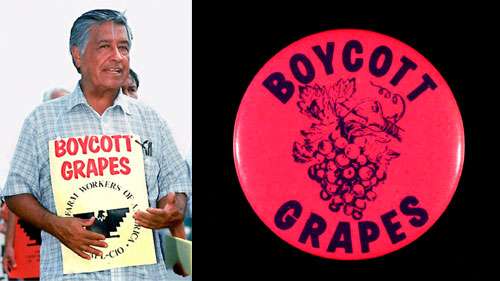
Starting
in 1966, Cesar Chavez, and the United
Farmer Workers labor union (UFW) he
helped found, began organizing a series
of boycotts to protest for higher
wages and safer working conditions
for farm workers. In the first effort,
the UFW urged all Americans not to
buy grapes to show their support for
the workers. This boycott lasted six
years and captured national attention.
Similar boycotts and strikes took
place throughout the 60s and 70s,
leading to legislation that guaranteed
higher wages, the banning of toxic
pesticides and other safety issues
for workers. These efforts clearly
demonstrated the effective potential
power for social transformation that
can be achieved by creating movements
that engage average citizens to join
in specific actions for a social cause.
|
1968
"Operating Manual for Spaceship
Earth "
|
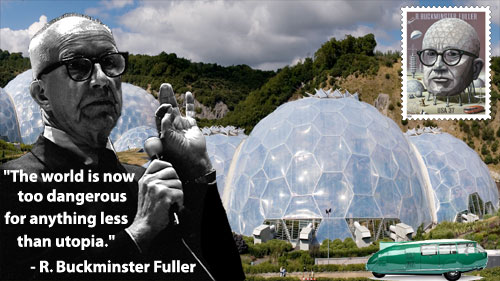
“You
never change things by fighting the
existing reality. To change something,
build a new model that makes the existing
model obsolete.” - R. Buckminster
Fuller
R.
Buckminster Fuller was an architect
and utopian futurist who challenged
the status quo of continuing on a
path that he saw was leading to the
destruction of our planet. Instead,
Bucky Fuller created revolutionary
new models in architectural design
and ways of thinking to create an
alternate paradigm for a positive
future for humanity. An early environmental
activist and pioneer in the concept
of thinking globally, he popularized
the term "Spaceship Earth" to express
concern about the limited resources
on our planet, and the need for the
global community to work together
for the benefit of all. Bucky Fuller
wrote more than 30 books, including
Operating Manual for Spaceship
Earth in 1968 and Utopia or
Oblivion in 1969, and is known
for numerous inventions and designs
like the geodesic dome, which have
inspired countless others to re-imagine
new ways to make the world a better
place. To truly change the existing
paradigm, Buckminster Fuller strongly
believed that the global economy should
be transformed so that true wealth
would be measured by the "technological
ability to protect, nurture, support,
and accommodate all growth needs of
life."
|
1970
-
EARTH DAY
|
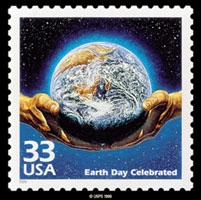 The
environmental movement is one of the
most successful social change movements.
Popularizing Earth Day celebrations
can be credited with bringing the
movement to the mainstream. Through
grassroots efforts, festivals, fairs,
assemblies and concerts have helped
popularize concern for our environment
in the public's mind. Since so many
people participate in Earth Day activities,
Earth Day is the perfect opportunity
to get people to tap-into the better
world movement, so that they can find
the inspiration and encouragement
to continue activities for a more
peaceful, just and sustainable world
all year long. When is Earth Day?
Actually, there are 3 Earth Days -
3 dates that are dedicated to helping
raise awareness about the health and
well being of the land, skies and
water of our planet Earth. The original
Earth Day is celebrated on the Spring
Equinox each year. April 22 is the
date that most people know as Earth
Day. Both of these Earth Days were
first celebrated in 1970 - on March
21 and April 22. In 1972, the United
Nations designated June 5 as World
Environment Day to commemorate the
opening of the Conference on the Human
Environment in Stockholm that year,
which ultimately led to the creation
of the United Nations Environment
Programme (UNEP), the main UN body
devoted to protecting our environment. The
environmental movement is one of the
most successful social change movements.
Popularizing Earth Day celebrations
can be credited with bringing the
movement to the mainstream. Through
grassroots efforts, festivals, fairs,
assemblies and concerts have helped
popularize concern for our environment
in the public's mind. Since so many
people participate in Earth Day activities,
Earth Day is the perfect opportunity
to get people to tap-into the better
world movement, so that they can find
the inspiration and encouragement
to continue activities for a more
peaceful, just and sustainable world
all year long. When is Earth Day?
Actually, there are 3 Earth Days -
3 dates that are dedicated to helping
raise awareness about the health and
well being of the land, skies and
water of our planet Earth. The original
Earth Day is celebrated on the Spring
Equinox each year. April 22 is the
date that most people know as Earth
Day. Both of these Earth Days were
first celebrated in 1970 - on March
21 and April 22. In 1972, the United
Nations designated June 5 as World
Environment Day to commemorate the
opening of the Conference on the Human
Environment in Stockholm that year,
which ultimately led to the creation
of the United Nations Environment
Programme (UNEP), the main UN body
devoted to protecting our environment.
EarthSite.org
EarthDay.org
|
October
11, 1971-
"Imagine"
|
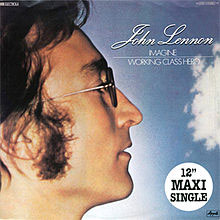 For
many people, John Lennon's song Imagine
is the perfect anthem for the shared
utopian vision a more peaceful, just
and sustainable world. The best-selling
single of his career asks us to imagine
a world where we live life to the
fullest, unattached to material possessions
and without the barriers and divisiveness
of borders, nationalities and religions.
Lennon's wife Yoko Ono said that the
song summed up "just what John believed:
that we are all one country, one world,
one people." Rolling Stone ranked
"Imagine" number 3 on its list of
the 500 Greatest Songs of All Time,"
and stated that "It is now impossible
to imagine a world without 'Imagine',
and we need it more than he ever dreamed."
The song is universal and is beloved
all around the world -- Former US
President and humanitarian Jimmy Carter
said, "in many countries around the
world - my wife and I have visited
about 125 countries - you hear John
Lennon's song 'Imagine' used almost
equally with national anthems." For
many people, John Lennon's song Imagine
is the perfect anthem for the shared
utopian vision a more peaceful, just
and sustainable world. The best-selling
single of his career asks us to imagine
a world where we live life to the
fullest, unattached to material possessions
and without the barriers and divisiveness
of borders, nationalities and religions.
Lennon's wife Yoko Ono said that the
song summed up "just what John believed:
that we are all one country, one world,
one people." Rolling Stone ranked
"Imagine" number 3 on its list of
the 500 Greatest Songs of All Time,"
and stated that "It is now impossible
to imagine a world without 'Imagine',
and we need it more than he ever dreamed."
The song is universal and is beloved
all around the world -- Former US
President and humanitarian Jimmy Carter
said, "in many countries around the
world - my wife and I have visited
about 125 countries - you hear John
Lennon's song 'Imagine' used almost
equally with national anthems."
|
1981
-
The International Day of Peace
|
 The
International Day of Peace was established
by the United Nations in 1981 as a
worldwide day of peace, and since
its inception it has inspired millions
to find ways to promote hope for a
more peaceful, just and sustainable
world.
The
International Day of Peace was established
by the United Nations in 1981 as a
worldwide day of peace, and since
its inception it has inspired millions
to find ways to promote hope for a
more peaceful, just and sustainable
world.
In
2001, a new UN Resolution changed
the date for the observance of the
International Day of Peace to September
21. Until then, it had been tied to
the opening of the General Assembly
of the United Nations. This was the
day when the governments of the world
began their work together for the
new year, and starting with a day
dedicated to peace was a powerful
symbol of shared intention. But some
felt that since the General Assembly
did not begin on a fixed date each
year, it made it difficult for it
to become a mainstreamed day of celebration
around the world. The New Resolution
also included stronger language calling
upon nations, organizations and individuals
to observe the day as a global ceasefire,
in addition to celebrating it as a
day of peace.
InternationalDayOfPeace.org
|
1981
Ashoka: Innovators for the Public
|
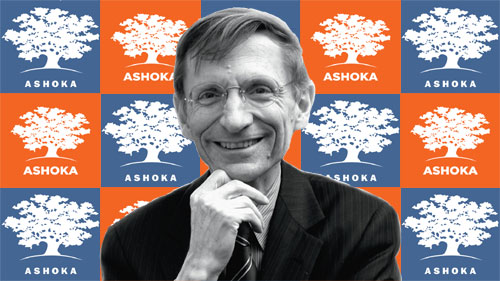
“The
core psychology of a social entrepreneur
is someone who cannot come to rest,
in a very deep sense, until he or
she has changed the pattern in an
area of social concern all across
society.” - Bill Drayton
In
a better world, everyone would be
able to earn their livelihood at jobs
that help to make the world a better
place. Many people today are finding
ways to work for a better world and
make a living at the same time. A
social entrepreneur is someone who
sees a social problem and creates
a new and innovative way to address
it. While some social entrepreneurs
work through nonprofits, citizen groups
or government programs, many create
sustainable businesses to address
the problem. Typical businesses measure
their success by the amount of profit
they make; social entrepreneurs measure
their success by how big an impact
they make in bringing about social
change.
The
term 'social entrepreneur' is fairly
new - it was first used in the 1960s
and 1970s. But social entrepreneurs
can be found all throughout history
and include many historical figures,
like Florence Nightingale who established
the first nursing school. The
modern social entrepreneur movement
began in 1981 when social entrepreneurial
pioneer Bill Drayton founded Ashoka:
Innovators for the Public to identify
and support social entrepreneurs.
To date, Ashoka has supported more
than 1800 social entrepreneurs in
over 60 countries. Now there are quite
a number of organizations that promote
social entrepreneurship as an important
way to address today's social problems.
(more)
|
1982
Newman's Own: All Profits to Charity
|
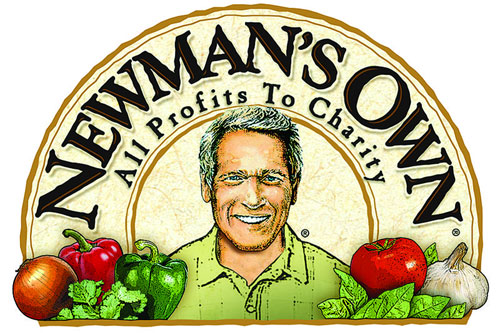
Paul
Newman is best known as an Academy-award
winning movie star, featured in more
than 50 movies, but he was also a
professional racing car driver and
trailblazing philanthropist. In 1982,
Paul Newman co-founded Newman's Own,
a for profit food company that donates
all of its after-tax profits to charity;
so far Newman's Own has donated more
than $300 million! This new idea of
providing goods and services as a
way to raise money for charities,
instead of simply asking for donations,
is a revolutionary approach to funding
philanthropic efforts, and has inspired
many other social entrepreneurial
ventures.
|
1985
-
77 THESES ON THE CARE OF THE EARTH
|
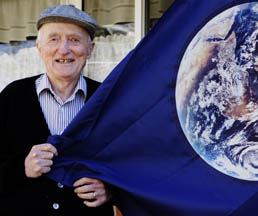 John
McConnell, the founder of the original
Earth Day, created many significant
projects and campaigns for a more
peaceful, just and sustainable world
including a 1957 Star of Hope
proposal, calling for peaceful international
cooperation for space exploration;
Meals For Millions to feed
refugees in 1962, and the Minute
For Peace campaign to bring the
world together in a moment of silence
for peace in 1963. He wrote several
blueprints for a better world, including
an original Earth Charter document
in 1979, and a comprehensive plan
for a better world entitled, 77
Theses On the Care of the Earth: A
Guide for Earth Trustees - Principles
and Policies that will foster the
peaceful nurture and care of the planet
Earth in 1985. John
McConnell, the founder of the original
Earth Day, created many significant
projects and campaigns for a more
peaceful, just and sustainable world
including a 1957 Star of Hope
proposal, calling for peaceful international
cooperation for space exploration;
Meals For Millions to feed
refugees in 1962, and the Minute
For Peace campaign to bring the
world together in a moment of silence
for peace in 1963. He wrote several
blueprints for a better world, including
an original Earth Charter document
in 1979, and a comprehensive plan
for a better world entitled, 77
Theses On the Care of the Earth: A
Guide for Earth Trustees - Principles
and Policies that will foster the
peaceful nurture and care of the planet
Earth in 1985.
(more)
|
1988
-
Global Cooperation for a Better World
/ Visions of a Better World
|
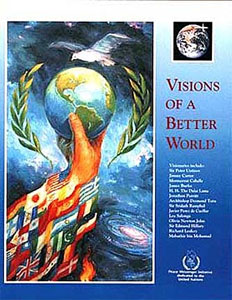 The
Global Cooperation project was a Peace
Messenger collaboration between the
United Nations and the NGO, Brahma
Kumaris World Spiritual University,
in which hundreds of thousands of
people in more than 120 countries
were asked to share in words or pictures
their response to the question "What
is your vision of a Better World?"
The ideas and actions offered were
compiled and a Global Vision Statement
was created, based on the common visions
shared. The
Global Cooperation project was a Peace
Messenger collaboration between the
United Nations and the NGO, Brahma
Kumaris World Spiritual University,
in which hundreds of thousands of
people in more than 120 countries
were asked to share in words or pictures
their response to the question "What
is your vision of a Better World?"
The ideas and actions offered were
compiled and a Global Vision Statement
was created, based on the common visions
shared.
(More)
|
1991
-
Earth Constitution
|
 The
World Constitution and Parliament
Association is a worldwide association
of citizens, chapters, and affiliated
organizations that was launched
in 1958 with the purpose of creating
an enforceable democratic world
government constitution. In 1991,
after 33 years of consultations
and constituent assemblies, an Earth
Constitution was drafted that would
establish a democratic nonmilitary
global government with enforceable
environmental and human rights laws. Since then, the Earth Federation Movement (EFM) -- the global movement
to raise awareness and support for
this constitution -- continues to
advocate for a democratic federation
of nations and peoples under the
Earth Constitution. The
World Constitution and Parliament
Association is a worldwide association
of citizens, chapters, and affiliated
organizations that was launched
in 1958 with the purpose of creating
an enforceable democratic world
government constitution. In 1991,
after 33 years of consultations
and constituent assemblies, an Earth
Constitution was drafted that would
establish a democratic nonmilitary
global government with enforceable
environmental and human rights laws. Since then, the Earth Federation Movement (EFM) -- the global movement
to raise awareness and support for
this constitution -- continues to
advocate for a democratic federation
of nations and peoples under the
Earth Constitution.
Earth
Constitution
Earth
Federation Movement
|
June
3-14, 1992 -
The Earth Summit
|
 The
formation of the United Nations
created a vehicle for the governments
of the world to work together to
address the shared problems of the
global community. For the most serious
issues, major global conferences
are held, where leaders, national
experts and civil society activists
participate with the intent of agreeing
on a course of action to address
the issue. Often the NGO (non-governmental
organizations) community will hold
a mirror-event at the same time
to ensure that civil society's voice
is heard as well as governmental
interests. Follow-up forums are
often held five, ten and twenty
years later to gauge progress and
re-ignite mainstream awareness and
action on the issue. This powerful
paradigm-shifting trend was largely
launched at The Earth Summit (officially
the United Nations Conference on
Environment and Development) in
Rio de Janeiro from June 3-14, 1992.
172 governments and 2400 NGO representatives
participated, and 17,000 more global
citizens attended a parallel NGO
Forum. Numerous critical environmental
issues were brought to attention,
including global climate change,
alternative energy, the growing
scarcity of water, sustainable development
and biodiversity. The
formation of the United Nations
created a vehicle for the governments
of the world to work together to
address the shared problems of the
global community. For the most serious
issues, major global conferences
are held, where leaders, national
experts and civil society activists
participate with the intent of agreeing
on a course of action to address
the issue. Often the NGO (non-governmental
organizations) community will hold
a mirror-event at the same time
to ensure that civil society's voice
is heard as well as governmental
interests. Follow-up forums are
often held five, ten and twenty
years later to gauge progress and
re-ignite mainstream awareness and
action on the issue. This powerful
paradigm-shifting trend was largely
launched at The Earth Summit (officially
the United Nations Conference on
Environment and Development) in
Rio de Janeiro from June 3-14, 1992.
172 governments and 2400 NGO representatives
participated, and 17,000 more global
citizens attended a parallel NGO
Forum. Numerous critical environmental
issues were brought to attention,
including global climate change,
alternative energy, the growing
scarcity of water, sustainable development
and biodiversity.
|
1992
-
UNESCO Culture of Peace Programme
|
 A
Culture of Peace is a paradigm
shift in which individuals, organizations,
neighborhoods and nations join together
as a global community in a common
goal: to work towards creating a more
peaceful, just and sustainable world.
Our current culture is driven by the
global economy and it affects our
everyday lives, and our outlook about
the world and our future. The aim
of the global movement that has arisen
to promote a culture of peace, is
to transform our focus from the global
economy to the care and well-being
of our interconnected global community.
The
Global Movement For
a Culture of Peace arose out of the
UNESCO Culture of Peace Programme
which was
adopted by UNESCO in 1992, and sought
to create national culture of peace
programs that could be implemented
in UN member countries. In 1999,
the United Nations General Assembly
adopted a resolution, entitled the
Declaration and Programme
of Action on a Culture of Peace that
called for a global movement for the
culture of peace, inviting member
states, civil society organizations
and individuals in all walks of life
to join in partnership with the United
Nations. A
Culture of Peace is a paradigm
shift in which individuals, organizations,
neighborhoods and nations join together
as a global community in a common
goal: to work towards creating a more
peaceful, just and sustainable world.
Our current culture is driven by the
global economy and it affects our
everyday lives, and our outlook about
the world and our future. The aim
of the global movement that has arisen
to promote a culture of peace, is
to transform our focus from the global
economy to the care and well-being
of our interconnected global community.
The
Global Movement For
a Culture of Peace arose out of the
UNESCO Culture of Peace Programme
which was
adopted by UNESCO in 1992, and sought
to create national culture of peace
programs that could be implemented
in UN member countries. In 1999,
the United Nations General Assembly
adopted a resolution, entitled the
Declaration and Programme
of Action on a Culture of Peace that
called for a global movement for the
culture of peace, inviting member
states, civil society organizations
and individuals in all walks of life
to join in partnership with the United
Nations.
(More)
|
1992
-
World Peace Plan
4000 IDEAS & DREAMS FOR A BETTER WORLD
|
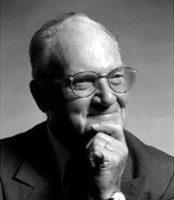 Robert
Muller was called many things during
his life, such as the "Prophet of
Hope" and "Philosopher of the United
Nations" for his many years at the
UN; the "Father of Global Education"
because of his "World Core Curriculum"
that is used in dozens of Robert Muller
Schools around the world and earned
him the UNESCO Peace Education Prize
in 1989; and "One of greatest
visionaries you've never heard of."
Dr. Muller began working at the United
Nations shortly after it was created
and served as Assistant-Secretary
General under three United Nations
Secretary Generals. Behind the scenes
he helped popularize the idea of observing
international days, years and decades
to unite the world in celebration
and action for a particular social
issue; the observance of the International
Day of Peace beginning in 1981, for
example, was largely due to his efforts
working with the NGO, Pathways To
Peace. Robert
Muller co-founded the UN's University
For Peace in Costa Rica and was nominated
22 times for the Nobel Peace Prize.
His life and all of his 20 books were
devoted to helping create a more peaceful,
just and sustainable world. Robert
Muller was called many things during
his life, such as the "Prophet of
Hope" and "Philosopher of the United
Nations" for his many years at the
UN; the "Father of Global Education"
because of his "World Core Curriculum"
that is used in dozens of Robert Muller
Schools around the world and earned
him the UNESCO Peace Education Prize
in 1989; and "One of greatest
visionaries you've never heard of."
Dr. Muller began working at the United
Nations shortly after it was created
and served as Assistant-Secretary
General under three United Nations
Secretary Generals. Behind the scenes
he helped popularize the idea of observing
international days, years and decades
to unite the world in celebration
and action for a particular social
issue; the observance of the International
Day of Peace beginning in 1981, for
example, was largely due to his efforts
working with the NGO, Pathways To
Peace. Robert
Muller co-founded the UN's University
For Peace in Costa Rica and was nominated
22 times for the Nobel Peace Prize.
His life and all of his 20 books were
devoted to helping create a more peaceful,
just and sustainable world.
In
1992, Robert Muller drafted the steps
for a Peace Plan to achieve world
peace by 2010 which was based on his
1991 novel, First Lady of the World,
in which he serves as advisor to the
first woman Secretary General of the
United Nations and helps her create
world peace. In 1995 he completed
the first 500 of his 4000 Ideas
and Dreams for a Better World.
This monumental work continues to
inspire countless 'dreamers' to believe
that together we can create a better
world.
RobertMuller.org
|
1995
- "When Corporations Rule The World"
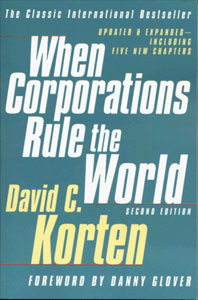  David Korten's 1995 book, When Corporations
Rule the World helped to spur the
anti-globalization movement by presenting
a clear and concrete case against the
global consolidation of corporate power,
market deregulation, privatization and
the overriding emphasis on consumerism,
while convincingly outlining an alternative
path of 'people-centered development'
by increasing local, national and global
control over international corporations
and finance to encourage corporate social
and environmental responsibility, and
creating local economies that utilize
local resources rather than expanding
international trade.
David Korten's 1995 book, When Corporations
Rule the World helped to spur the
anti-globalization movement by presenting
a clear and concrete case against the
global consolidation of corporate power,
market deregulation, privatization and
the overriding emphasis on consumerism,
while convincingly outlining an alternative
path of 'people-centered development'
by increasing local, national and global
control over international corporations
and finance to encourage corporate social
and environmental responsibility, and
creating local economies that utilize
local resources rather than expanding
international trade. |
1996
- "The Peace On Earth Millennium"
|
 In
his 1996 book, The Peace On Earth
Millennium and 2003 follow-up,
We Want Peace On Earth!, utopian
author Robert Alan Silverstein makes
the case that many diverse movements
for a more peaceful, just and sustainable
world have been evolving and converging
into an emerging, as yet unnamed holistic
movement. He called it the Peace
On Earth Movement, because although
it can be traced back through many
different social-movement paths, the
goal of each shares a vision of a
world at peace, balance and harmony
that can best be described as peace
on earth. Once we recognize that so
many things are already being done
by so many people to help create this
shared vision, we will be inspired
and empowered to make striving towards
peace on earth our personal and societal
goal.
In
his 1996 book, The Peace On Earth
Millennium and 2003 follow-up,
We Want Peace On Earth!, utopian
author Robert Alan Silverstein makes
the case that many diverse movements
for a more peaceful, just and sustainable
world have been evolving and converging
into an emerging, as yet unnamed holistic
movement. He called it the Peace
On Earth Movement, because although
it can be traced back through many
different social-movement paths, the
goal of each shares a vision of a
world at peace, balance and harmony
that can best be described as peace
on earth. Once we recognize that so
many things are already being done
by so many people to help create this
shared vision, we will be inspired
and empowered to make striving towards
peace on earth our personal and societal
goal.
|
September
18, 1997
Mine Ban Treaty
|
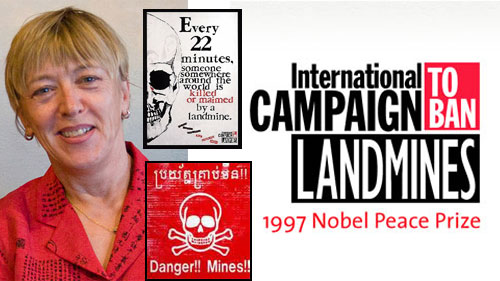
The
International Campaign to Ban Landmines
(ICBL) is one of the great success
stories of grassroots organizing that
proves Margaret Mead's famous quotation:
"Never doubt that a small group of
thoughtful, committed citizens can
change the world. Indeed, it is the
only thing that ever has." In 1992
several Non Governmental Organizations
that were concerned about the 100
million buried landmines on roads
and footpaths in more than 60 countries
which kill or maim an innocent civilian
every 22 seconds, decided to work
together on a global campaign to ban
these deadly weapons. Human rights
activist, Jody Williams headed the
campaign, and grew the network to
more than 1300 active organizations
in 95 countries, all before the popularity
of the Internet and the advent of
other social media tools we have available
today. The campaign brought the issue
to mainstream attention and resulted
in the drafting of the Mine Ban Treaty
on September 18, 1997. To date, more
than 160 nations have ratified the
UN treaty, but 36 countries, including
the United States, Russia and China
have yet to do so. Jody Williams and
the ICBL received the Nobel Peace
Prize in 1997 for their lifesaving
work. Although landmines continue
to kill and cripple innocent people,
the Treaty has given organizations
and governments a valuable tool in
ending the use of landmines, and the
campaign has inspired countless other
activist-networks in their efforts
to create a more peaceful, just and
sustainable world.
icbl.org
|
1997
- Appeal of the Nobel Laureates
for the Children of the World
|

Pierre
Marchand, founder of the French humanitarian
organization Partage which helps children
in places of war, set out on a mission
in 1997 to convince all of the Nobel
Peace Prize laureates to join together
to appeal to the world's governments
to make peace and nonviolence for
the children of the world a priority.
He traveled around the world and secured
the participation of all 27 Nobel
Peace Prize winners alive at the time.
Their appeal stressed the need to
help educate young people with tools
for peace and nonviolence. Then UNESCO
and the Appeal of the Nobel Laureates
worked to gather 100 million signatures
to present at a special Millennium
Assembly in the Year 2000. With UNESCO's
support, this initiative helped convince
the United Nations to declare the
Year 2000 as the International Year
for a Culture of Peace, and the first
decade of the new Millennium as The
International Decade for a Culture
of Peace and Nonviolence for the Children
of the World. During the Decade, thousands
of organizations participated in events
and activities to raise awareness
about the growing culture of peace
movement and the importance of peace
and nonviolence education. The Peace
Kids story, Peace
Kids Pledge tells the story of
the Appeal of the Nobel Laureates
and offers a Peace
Pledge based on the Appeal that
young people can use to pledge their
support to live more peaceful lives.
|
1998
- "Conscious Evolution"
  Barbara
Marx Hubbard’s 1998 book, Conscious
Evolution: Awakening the Power of Our
Social Potential, helped to
present the ideas of the conscious evolution
movement, which asserts that we now
have the ability and the technological,
medical, psychological and spiritual
tools to consciously choose which direction
humanity’s future will take and how
we will evolve as a species. This movement
asserts that we have the choice to move
forward through cooperation and co-creation
or to move toward self-destruction by
choosing a path of separation and competition.
As humanity consciously evolves, we
help guide the evolution of the universe
as well. Other visionaries who write
about conscious evolution include: Deepak
Chopra, Andrew
Cohen, Duane
Elgin, Jean
Houston, Barbara
Marx Hubbard, Ervin
Laszlo, Elisabet
Sahtouris
and Marianne
Williamson.
Barbara
Marx Hubbard’s 1998 book, Conscious
Evolution: Awakening the Power of Our
Social Potential, helped to
present the ideas of the conscious evolution
movement, which asserts that we now
have the ability and the technological,
medical, psychological and spiritual
tools to consciously choose which direction
humanity’s future will take and how
we will evolve as a species. This movement
asserts that we have the choice to move
forward through cooperation and co-creation
or to move toward self-destruction by
choosing a path of separation and competition.
As humanity consciously evolves, we
help guide the evolution of the universe
as well. Other visionaries who write
about conscious evolution include: Deepak
Chopra, Andrew
Cohen, Duane
Elgin, Jean
Houston, Barbara
Marx Hubbard, Ervin
Laszlo, Elisabet
Sahtouris
and Marianne
Williamson. |
May
11-15, 1999 -
Hague Appeal For Peace
|
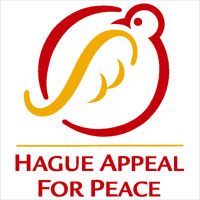 As
the Second Millennium and history's
bloodiest century came to a close,
the largest international peace conference
ever took place in The Hague, Netherlands
from May 11-15, 1999. 10,000 people
from over 100 countries gathered for
the Hague Appeal for Peace on the
100th Anniversary of the First Hague
Peace Conference, to attend over 400
workshops and panels and to discuss
how humanity could begin the next
millennium working together to abolish
war as an option to solve problems
within and between nations. At the
conference, The Hague Agenda for
Peace & Justice, containing 50
steps to creating a more peaceful,
just and sustainable world was agreed
upon, and The Global Campaign for
Peace Education was launched to
help teach the necessary tools to
create a better world. As
the Second Millennium and history's
bloodiest century came to a close,
the largest international peace conference
ever took place in The Hague, Netherlands
from May 11-15, 1999. 10,000 people
from over 100 countries gathered for
the Hague Appeal for Peace on the
100th Anniversary of the First Hague
Peace Conference, to attend over 400
workshops and panels and to discuss
how humanity could begin the next
millennium working together to abolish
war as an option to solve problems
within and between nations. At the
conference, The Hague Agenda for
Peace & Justice, containing 50
steps to creating a more peaceful,
just and sustainable world was agreed
upon, and The Global Campaign for
Peace Education was launched to
help teach the necessary tools to
create a better world.
HaguePeace.org
|
January
1, 2000
One Day In Peace, JANUARY 1
|
 In the 1990s, a number of individuals
and organizations had the idea of
beginning the approaching New Millennium
with a worldwide day of peace. Just
as we are inspired to make resolutions
for New Year's each year, they saw
this as a unique opportunity for
a New Beginning for humanity, a
chance to convince the world to
CHOOSE the ultimate shared resolution
of striving towards peace on earth
on this monumental New Year's day.
Many of the efforts joined together
to synergistically create humanity's
very first shared day of peace.
One of the efforts was launched
with the 1996 picture book, One
Day In Peace, January 1, 2000,
written by Steve Diamond and Robert
Alan Silverstein. The book called
for a worldwide day of peace and
global ceasefire on January 1, 2000
and was translated into 21 languages.
A copy was sent to every world leader
and it inspired the formation of
the One Day In Peace Network, an
association of more than 1000 organizations
in 140 countries, which secured
a pledge of support from 100 Heads
of State; 25 US Governors and hundreds
of Mayors around the world declared
Proclamations; and the US Congress
and the United Nations declared
January 1 as a day of peace. After
January 1, 2000, the campaign continued
under the leadership of Global Family
Day, which secured ongoing international
support of January 1 as a Global
Day of Peace and Sharing.
In the 1990s, a number of individuals
and organizations had the idea of
beginning the approaching New Millennium
with a worldwide day of peace. Just
as we are inspired to make resolutions
for New Year's each year, they saw
this as a unique opportunity for
a New Beginning for humanity, a
chance to convince the world to
CHOOSE the ultimate shared resolution
of striving towards peace on earth
on this monumental New Year's day.
Many of the efforts joined together
to synergistically create humanity's
very first shared day of peace.
One of the efforts was launched
with the 1996 picture book, One
Day In Peace, January 1, 2000,
written by Steve Diamond and Robert
Alan Silverstein. The book called
for a worldwide day of peace and
global ceasefire on January 1, 2000
and was translated into 21 languages.
A copy was sent to every world leader
and it inspired the formation of
the One Day In Peace Network, an
association of more than 1000 organizations
in 140 countries, which secured
a pledge of support from 100 Heads
of State; 25 US Governors and hundreds
of Mayors around the world declared
Proclamations; and the US Congress
and the United Nations declared
January 1 as a day of peace. After
January 1, 2000, the campaign continued
under the leadership of Global Family
Day, which secured ongoing international
support of January 1 as a Global
Day of Peace and Sharing.
OneDay.net
|
June
29, 2000 -
The Earth Charter
|
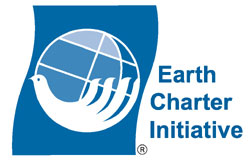 The
Earth Charter is one of the most significant
comprehensive blueprints for a better
world. It provides a framework for
a holistic ethical vision, calling
for global partnership to address
our interdependent need for environmental
protection, human rights, equitable
human development and peace. The
Earth Charter is one of the most significant
comprehensive blueprints for a better
world. It provides a framework for
a holistic ethical vision, calling
for global partnership to address
our interdependent need for environmental
protection, human rights, equitable
human development and peace.
(more)
|
September,
2000 -
MILLENNIUM DEVELOPMENT GOALS
|
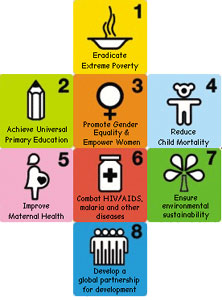 At
the Millennium Summit in September
2000 at the United Nations, ALL of
the world's leaders agreed "to spare
no effort" in working to fulfill the
Millennium Development Goals (MDGs)
by 2015. These shared goals help us
take a giant step forward in global
cooperation to create a more peaceful,
just and sustainable world. Help join
the campaign to remind our leaders
about their PROMISE. At
the Millennium Summit in September
2000 at the United Nations, ALL of
the world's leaders agreed "to spare
no effort" in working to fulfill the
Millennium Development Goals (MDGs)
by 2015. These shared goals help us
take a giant step forward in global
cooperation to create a more peaceful,
just and sustainable world. Help join
the campaign to remind our leaders
about their PROMISE.
(more)
|
January
25-30, 2001 -
World Social Forum
|
 The World Social Forum is an annual
meeting of activists and civil society
organizations that arose out of the
anti-globalization movement as a people's
alternative to the World Economic
Forum. At the first meeting in Brazil
in 2001 the shared motto of "Another
world is possible" became the uniting
banner of hope for activists share
proposals and experiences and create
alliances to build a more peaceful,
just and sustainable world.
The World Social Forum is an annual
meeting of activists and civil society
organizations that arose out of the
anti-globalization movement as a people's
alternative to the World Economic
Forum. At the first meeting in Brazil
in 2001 the shared motto of "Another
world is possible" became the uniting
banner of hope for activists share
proposals and experiences and create
alliances to build a more peaceful,
just and sustainable world.
WorldSocialForum.org
|
October,
2001 -
"The Better World Handbook"

|
The
Better World Handbook is a comprehensive,
in-depth, how-to manual for building
a better world. It convincingly illustrates
how small every day changes can make
a big difference, because all around
the world millions of others are also
doing things to make the world a better
place. The Better World Handbook
suggests that a more coordinated 'Better
World Movement' is arising as people
become more aware of their impact
and of the widespread efforts of many
others who share their vision of a
more peaceful, just and sustainable
world.
|
July
1, 2002 -
"The International Criminal Court"
|
The
creation of international laws that
protect human rights and the environment
is only the first step in creating
the parameters for behavior in a more
peaceful, just and sustainable world;
the other half of the equation is
a legal body with the authority to
enforce these laws. On July 17, 1998,
a historic milestone was reached when
120 nations adopted the Rome Statute,
which was the legal basis for creating
a permanent International Criminal
Court. On July 1, 2002, the Rome Statute
came into force after 60 nations had
ratified it, and the International
Criminal Court was officially established
in The Hague in the Netherlands.
icc-cpi.int
|
2005
-
Clinton Global Initiative
|
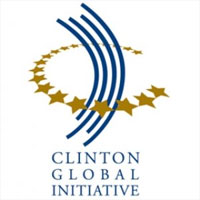 In 2005, former US President Bill
Clinton founded the Clinton Global
Initiative as a nonpartisan organization
devoted to bringing together global
leaders, corporations and NGOs to
address the world's most critical
economic, education, energy, environmental,
health and women's issues. In addition
to the Annual Meeting in September
that coincides with the opening of
the General Assembly of the United
Nations, CGI also hosts an annual
conference for college students and
an annual event focused on finding
solutions to promote economic recovery.
In 2005, former US President Bill
Clinton founded the Clinton Global
Initiative as a nonpartisan organization
devoted to bringing together global
leaders, corporations and NGOs to
address the world's most critical
economic, education, energy, environmental,
health and women's issues. In addition
to the Annual Meeting in September
that coincides with the opening of
the General Assembly of the United
Nations, CGI also hosts an annual
conference for college students and
an annual event focused on finding
solutions to promote economic recovery.
ClintonGlobalInitiative.org
|
July
18, 2007-
The Elders
|
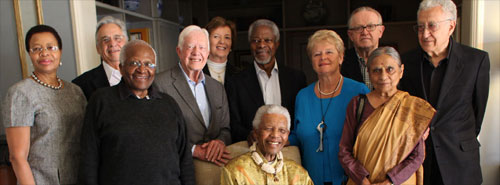
On
his 89th birthday in July 2007, Nelson
Mandela announced that Peter Gabriel
and billionaire entrepreneur Richard
Branson would be providing the funding
to launch The Elders, an international
non-governmental group of 12 of the
world's leading social change advocates
who would work together using their
"almost 1,000 years of collective
experience" to address the world's
most challenging peace, human rights,
environmental and health issues.
TheElders.org
|
September
17, 2011-
Occupy Wall Street
|
 Over
the years there have been numerous
protests and emerging movements seeking
to expose and address the growing
social and economic greed and corruption
that drives the global economy, and
which has created the greatest divide
in income distribution between the
wealthiest 1% and everyone else since
the Great Depression. Although unemployment
has reached epidemic proportions and
home foreclosures continue to skyrocket,
the media and the mainstream have
largely ignored these efforts for
change. On September 17, 2011, the
Occupy Wall Street movement suddenly
captured widespread mainstream attention,
and launched a global Occupy movement
that sustained media coverage far
longer than any movement has in the
past. The Occupy movement and it's
most powerful slogan, "We are the
99%", continues to be a uniting force
and rallying cry for local, national
and international efforts for a more
fair, just and equitable global economy. Over
the years there have been numerous
protests and emerging movements seeking
to expose and address the growing
social and economic greed and corruption
that drives the global economy, and
which has created the greatest divide
in income distribution between the
wealthiest 1% and everyone else since
the Great Depression. Although unemployment
has reached epidemic proportions and
home foreclosures continue to skyrocket,
the media and the mainstream have
largely ignored these efforts for
change. On September 17, 2011, the
Occupy Wall Street movement suddenly
captured widespread mainstream attention,
and launched a global Occupy movement
that sustained media coverage far
longer than any movement has in the
past. The Occupy movement and it's
most powerful slogan, "We are the
99%", continues to be a uniting force
and rallying cry for local, national
and international efforts for a more
fair, just and equitable global economy.
|
2015
-
The People For Bernie Sanders
|

When
Bernie Sanders decided to run for
President in the 2016 election, many
who wished for a better world were
filled with hope. Bernie Sanders'
longstanding reputation of fighting
for progressive values drew together
many diverse grassroots movements
to rally around his campaign. They
recognized the opportunity to bring
mainstream attention to a holistic
progressive agenda of social issues.
Foremost on the list was tackling
economic inequality by getting money
out of politics through ending Citizens
United and publicly financing elections,
breaking up the big banks and reining
in Wall Street, providing free higher
education and universal health care
for all, and guaranteeing a living
wage for every worker. Sanders called
for curtailing military spending and
seeking peaceful solutions to international
conflicts; getting serious about global
climate change, and a whole host of
other issues necessary to create a
more peaceful, just and sustainable
future. Political groups planned to
spend billions of dollars crafting
campaign messages leading up to the
2016 election, and many recognized
that this could be the next Big Moment
for a better world, as the Bernie
Sanders campaign promised to keep
these crucial issues at the forefront
of public attention.
PeopleForBernie.com
#FeelTheBern
|
|
Peacetopia.com
is administered by The People For Peace Project.
Text © Robert Alan Silverstein
unless otherwise noted.
Photos included for educational purposes under
the Fair Use provision
of the US Copyright Law, Title 17 U.S.C. section
107.
Comments:
pforpeace@aol.com
May
Peace Prevail
On Earth
|
 |
|
MILESTONES
6th
Century BC
"Tao
Te Ching"
5th
Century BC
"Five
Classics"
c.380
BC
"Republic"
1215
Magna
Carta
1516
"Utopia"
1528
"On
Civil Power"
1568
Edict
of Torda
1625
"On
The Law
of War and Peace"
1648
Peace
of Westphalia
1650-1799
Enlightenment
1689
"Two
Treatises of Government"
1762
"Social
Contract"
July
4, 1776
US
Declaration of Independence
September
17, 1787
US
Constitution
August
26, 1789
Declaration
of the Rights of Man and of the Citizen
September
25, 1789
US
Bill of Rights
1793
Department
of Peace
1795
"Perpetual
Peace"
1814
On
The Reorganization of European Society
1815
Peace
Societies
April
27, 1825
New
Harmony
1836
New
Moral World
1843
International
Peace Congress
1849
"Civil
Disobedience"
February
1, 1865
13th
Amendment
Abolishing Slavery
1879
"Progress
and Poverty"
May
18, 1899
Hague
Peace Conference
1901
Nobel
Peace Prize
1906-1914
Satyagraha
January
8, 1918
14
Points
June
28, 1919
League
of Nations
1920
19th
Amendment:
Women's Right
to Vote
1933
The
New Deal
April
15, 1935
Pax
Cultura -
The Roerich Pact
August
14, 1935
Social
Security Act
1938
Fair
Labor
Standards Act
January
6, 1941
The
Four Freedoms
October
24, 1945
The
United Nations
August,
1947
World
Federalist Movement
December
10, 1948
Universal
Declaration of Human Rights
1955
"Let
There Be
Peace On Earth"
1955
May
Peace
Prevail On Earth"
July
9, 1955
Russell-Einstein
Manifesto
1956
The
Beloved Community
1960-1963
The
New Frontier
March
1, 1961
Peace
Corps
August
28, 1963
"I
Have a Dream"
1963-1969
The
Great Society
July
2, 1964
Civil
Rights Act
of 1964
1966
Grape
Boycott
1968
"Operating
Manual
for Spaceship Earth"
1970
Earth
Day
October
11, 1971
"Imagine"
1981
International
Day of Peace
1981
Ashoka:
Innovators for the Public
1982
Newman's
Own
1985
77
Theses on the Care of the Earth
1988
Global
Cooperation for a Better World
1991
Earth
Constitution
June,
1992
The
Earth Summit
1992
UNESCO
Culture of Peace Programme
1992
"4000
Ideas & Dreams for a Better World"
1995
Earth
Magna Charta
1995
"When
Corporations Rule The World"
1996
"Peace
On Earth Millennium"
Sep.
18, 1997
Mine
Ban Treaty
1997
Appeal
of the Nobel Laureates
1998
"Conscious
Evolution"
May
11-15, 1999
Hague
Appeal for Peace
January
1, 2000
One
Day In Peace
June
29, 2000
The
Earth Charter
September,
2000
Millennium
Development Goals
January
25-30, 2001
World
Social Forum
October,
2001
"Better
World Handbook"
July
1 , 2002
International
Criminal Court
2005
Clinton
Global Initiative
July
18, 2007
The
Elders
September
17, 2011
Occupy
Wall Street
2015
The
People For
Bernie Sanders
|
MILESTONES
6th
Century BC
"Tao
Te Ching"
5th
Century BC
"Five
Classics"
c.380
BC
"Republic"
1215
Magna
Carta
1516
"Utopia"
1528
"On
Civil Power"
1568
Edict
of Torda
1625
"On
The Law
of War and Peace"
1648
Peace
of Westphalia
1650-1799
Enlightenment
1689
"Two
Treatises of Government"
1762
"Social
Contract"
July
4, 1776
US
Declaration of Independence
September
17, 1787
US
Constitution
August
26, 1789
Declaration
of the Rights of Man and of the Citizen
September
25, 1789
US
Bill of Rights
1793
Department
of Peace
1795
"Perpetual
Peace"
1814
On
The Reorganization of European Society
1815
Peace
Societies
April
27, 1825
New
Harmony
1836
New
Moral World
1843
International
Peace Congress
1849
"Civil
Disobedience"
February
1, 1865
13th
Amendment
Abolishing Slavery
1879
"Progress
and Poverty"
May
18, 1899
Hague
Peace Conference
1901
Nobel
Peace Prize
1906-1914
Satyagraha
January
8, 1918
14
Points
June
28, 1919
League
of Nations
1920
19th
Amendment:
Women's Right
to Vote
1933
The
New Deal
April
15, 1935
Pax
Cultura -
The Roerich Pact
August
14, 1935
Social
Security Act
1938
Fair
Labor
Standards Act
January
6, 1941
The
Four Freedoms
October
24, 1945
The
United Nations
August,
1947
World
Federalist Movement
December
10, 1948
Universal
Declaration of Human Rights
1955
"Let
There Be
Peace On Earth"
1955
May
Peace
Prevail On Earth"
July
9, 1955
Russell-Einstein
Manifesto
1956
The
Beloved Community
1960-1963
The
New Frontier
March
1, 1961
Peace
Corps
August
28, 1963
"I
Have a Dream"
1963-1969
The
Great Society
July
2, 1964
Civil
Rights Act
of 1964
1966
Grape
Boycott
1968
"Operating
Manual
for Spaceship Earth"
1970
Earth
Day
October
11, 1971
"Imagine"
1981
International
Day of Peace
1981
Ashoka:
Innovators for the Public
1982
Newman's
Own
1985
77
Theses on the Care of the Earth
1988
Global
Cooperation for a Better World
1991
Earth
Constitution
June,
1992
The
Earth Summit
1992
UNESCO
Culture of Peace Programme
1992
"4000
Ideas & Dreams for a Better World"
1995
Earth
Magna Charta
1995
"When
Corporations Rule The World"
1996
"Peace
On Earth Millennium"
Sep.
18, 1997
Mine
Ban Treaty
1997
Appeal
of the Nobel Laureates
1998
"Conscious
Evolution"
May
11-15, 1999
Hague
Appeal for Peace
January
1, 2000
One
Day In Peace
June
29, 2000
The
Earth Charter
September,
2000
Millennium
Development Goals
January
25-30, 2001
World
Social Forum
October,
2001
"Better
World Handbook"
July
1 , 2002
International
Criminal Court
2005
Clinton
Global Initiative
July
18, 2007
The
Elders
September
17, 2011
Occupy
Wall Street
2015
The
People For
Bernie Sanders
|
MILESTONES
6th
Century BC
"Tao
Te Ching"
5th
Century BC
"Five
Classics"
c.380
BC
"Republic"
1215
Magna
Carta
1516
"Utopia"
1528
"On
Civil Power"
1568
Edict
of Torda
1625
"On
The Law
of War and Peace"
1648
Peace
of Westphalia
1650-1799
Enlightenment
1689
"Two
Treatises of Government"
1762
"Social
Contract"
July
4, 1776
US
Declaration of Independence
September
17, 1787
US
Constitution
August
26, 1789
Declaration
of the Rights of Man and of the Citizen
September
25, 1789
US
Bill of Rights
1793
Department
of Peace
1795
"Perpetual
Peace"
1814
On
The Reorganization of European Society
1815
Peace
Societies
April
27, 1825
New
Harmony
1836
New
Moral World
1843
International
Peace Congress
1849
"Civil
Disobedience"
February
1, 1865
13th
Amendment
Abolishing Slavery
1879
"Progress
and Poverty"
May
18, 1899
Hague
Peace Conference
1901
Nobel
Peace Prize
1906-1914
Satyagraha
January
8, 1918
14
Points
June
28, 1919
League
of Nations
1920
19th
Amendment:
Women's Right
to Vote
1933
The
New Deal
April
15, 1935
Pax
Cultura -
The Roerich Pact
August
14, 1935
Social
Security Act
1938
Fair
Labor
Standards Act
January
6, 1941
The
Four Freedoms
October
24, 1945
The
United Nations
August,
1947
World
Federalist Movement
December
10, 1948
Universal
Declaration of Human Rights
1955
"Let
There Be
Peace On Earth"
1955
May
Peace
Prevail On Earth"
July
9, 1955
Russell-Einstein
Manifesto
1956
The
Beloved Community
1960-1963
The
New Frontier
March
1, 1961
Peace
Corps
August
28, 1963
"I
Have a Dream"
1963-1969
The
Great Society
July
2, 1964
Civil
Rights Act
of 1964
1966
Grape
Boycott
1968
"Operating
Manual
for Spaceship Earth"
1970
Earth
Day
October
11, 1971
"Imagine"
1981
International
Day of Peace
1981
Ashoka:
Innovators for the Public
1982
Newman's
Own
1985
77
Theses on the Care of the Earth
1988
Global
Cooperation for a Better World
1991
Earth
Constitution
June,
1992
The
Earth Summit
1992
UNESCO
Culture of Peace Programme
1992
"4000
Ideas & Dreams for a Better World"
1995
Earth
Magna Charta
1995
"When
Corporations Rule The World"
1996
"Peace
On Earth Millennium"
Sep.
18, 1997
Mine
Ban Treaty
1997
Appeal
of the Nobel Laureates
1998
"Conscious
Evolution"
May
11-15, 1999
Hague
Appeal for Peace
January
1, 2000
One
Day In Peace
June
29, 2000
The
Earth Charter
September,
2000
Millennium
Development Goals
January
25-30, 2001
World
Social Forum
October,
2001
"Better
World Handbook"
July
1 , 2002
International
Criminal Court
2005
Clinton
Global Initiative
July
18, 2007
The
Elders
September
17, 2011
Occupy
Wall Street
2015
The
People For
Bernie Sanders
|
MILESTONES
6th
Century BC
"Tao
Te Ching"
5th
Century BC
"Five
Classics"
c.380
BC
"Republic"
1215
Magna
Carta
1516
"Utopia"
1528
"On
Civil Power"
1568
Edict
of Torda
1625
"On
The Law
of War and Peace"
1648
Peace
of Westphalia
1650-1799
Enlightenment
1689
"Two
Treatises of Government"
1762
"Social
Contract"
July
4, 1776
US
Declaration of Independence
September
17, 1787
US
Constitution
August
26, 1789
Declaration
of the Rights of Man and of the Citizen
September
25, 1789
US
Bill of Rights
1793
Department
of Peace
1795
"Perpetual
Peace"
1814
On
The Reorganization of European Society
1815
Peace
Societies
April
27, 1825
New
Harmony
1836
New
Moral World
1843
International
Peace Congress
1849
"Civil
Disobedience"
February
1, 1865
13th
Amendment
Abolishing Slavery
1879
"Progress
and Poverty"
May
18, 1899
Hague
Peace Conference
1901
Nobel
Peace Prize
1906-1914
Satyagraha
January
8, 1918
14
Points
June
28, 1919
League
of Nations
1920
19th
Amendment:
Women's Right
to Vote
1933
The
New Deal
April
15, 1935
Pax
Cultura -
The Roerich Pact
August
14, 1935
Social
Security Act
1938
Fair
Labor
Standards Act
January
6, 1941
The
Four Freedoms
October
24, 1945
The
United Nations
August,
1947
World
Federalist Movement
December
10, 1948
Universal
Declaration of Human Rights
1955
"Let
There Be
Peace On Earth"
1955
May
Peace
Prevail On Earth"
July
9, 1955
Russell-Einstein
Manifesto
1956
The
Beloved Community
1960-1963
The
New Frontier
March
1, 1961
Peace
Corps
August
28, 1963
"I
Have a Dream"
1963-1969
The
Great Society
July
2, 1964
Civil
Rights Act
of 1964
1966
Grape
Boycott
1968
"Operating
Manual
for Spaceship Earth"
1970
Earth
Day
October
11, 1971
"Imagine"
1981
International
Day of Peace
1981
Ashoka:
Innovators for the Public
1982
Newman's
Own
1985
77
Theses on the Care of the Earth
1988
Global
Cooperation for a Better World
1991
Earth
Constitution
June,
1992
The
Earth Summit
1992
UNESCO
Culture of Peace Programme
1992
"4000
Ideas & Dreams for a Better World"
1995
Earth
Magna Charta
1995
"When
Corporations Rule The World"
1996
"Peace
On Earth Millennium"
Sep.
18, 1997
Mine
Ban Treaty
1997
Appeal
of the Nobel Laureates
1998
"Conscious
Evolution"
May
11-15, 1999
Hague
Appeal for Peace
January
1, 2000
One
Day In Peace
June
29, 2000
The
Earth Charter
September,
2000
Millennium
Development Goals
January
25-30, 2001
World
Social Forum
October,
2001
"Better
World Handbook"
July
1 , 2002
International
Criminal Court
2005
Clinton
Global Initiative
July
18, 2007
The
Elders
September
17, 2011
Occupy
Wall Street
2015
The
People For
Bernie Sanders
|
MILESTONES
6th
Century BC
"Tao
Te Ching"
5th
Century BC
"Five
Classics"
c.380
BC
"Republic"
1215
Magna
Carta
1516
"Utopia"
1528
"On
Civil Power"
1568
Edict
of Torda
1625
"On
The Law
of War and Peace"
1648
Peace
of Westphalia
1650-1799
Enlightenment
1689
"Two
Treatises of Government"
1762
"Social
Contract"
July
4, 1776
US
Declaration of Independence
September
17, 1787
US
Constitution
August
26, 1789
Declaration
of the Rights of Man and of the Citizen
September
25, 1789
US
Bill of Rights
1793
Department
of Peace
1795
"Perpetual
Peace"
1814
On
The Reorganization of European Society
1815
Peace
Societies
April
27, 1825
New
Harmony
1836
New
Moral World
1843
International
Peace Congress
1849
"Civil
Disobedience"
February
1, 1865
13th
Amendment
Abolishing Slavery
1879
"Progress
and Poverty"
May
18, 1899
Hague
Peace Conference
1901
Nobel
Peace Prize
1906-1914
Satyagraha
January
8, 1918
14
Points
June
28, 1919
League
of Nations
1920
19th
Amendment:
Women's Right
to Vote
1933
The
New Deal
April
15, 1935
Pax
Cultura -
The Roerich Pact
August
14, 1935
Social
Security Act
1938
Fair
Labor
Standards Act
January
6, 1941
The
Four Freedoms
October
24, 1945
The
United Nations
August,
1947
World
Federalist Movement
December
10, 1948
Universal
Declaration of Human Rights
1955
"Let
There Be
Peace On Earth"
1955
May
Peace
Prevail On Earth"
July
9, 1955
Russell-Einstein
Manifesto
1956
The
Beloved Community
1960-1963
The
New Frontier
March
1, 1961
Peace
Corps
August
28, 1963
"I
Have a Dream"
1963-1969
The
Great Society
July
2, 1964
Civil
Rights Act
of 1964
1966
Grape
Boycott
1968
"Operating
Manual
for Spaceship Earth"
1970
Earth
Day
October
11, 1971
"Imagine"
1981
International
Day of Peace
1981
Ashoka:
Innovators for the Public
1982
Newman's
Own
1985
77
Theses on the Care of the Earth
1988
Global
Cooperation for a Better World
1991
Earth
Constitution
June,
1992
The
Earth Summit
1992
UNESCO
Culture of Peace Programme
1992
"4000
Ideas & Dreams for a Better World"
1995
Earth
Magna Charta
1995
"When
Corporations Rule The World"
1996
"Peace
On Earth Millennium"
Sep.
18, 1997
Mine
Ban Treaty
1997
Appeal
of the Nobel Laureates
1998
"Conscious
Evolution"
May
11-15, 1999
Hague
Appeal for Peace
January
1, 2000
One
Day In Peace
June
29, 2000
The
Earth Charter
September,
2000
Millennium
Development Goals
January
25-30, 2001
World
Social Forum
October,
2001
"Better
World Handbook"
July
1 , 2002
International
Criminal Court
2005
Clinton
Global Initiative
July
18, 2007
The
Elders
September
17, 2011
Occupy
Wall Street
2015
The
People For
Bernie Sanders
|
MILESTONES
6th
Century BC
"Tao
Te Ching"
5th
Century BC
"Five
Classics"
c.380
BC
"Republic"
1215
Magna
Carta
1516
"Utopia"
1528
"On
Civil Power"
1568
Edict
of Torda
1625
"On
The Law
of War and Peace"
1648
Peace
of Westphalia
1650-1799
Enlightenment
1689
"Two
Treatises of Government"
1762
"Social
Contract"
July
4, 1776
US
Declaration of Independence
September
17, 1787
US
Constitution
August
26, 1789
Declaration
of the Rights of Man and of the Citizen
September
25, 1789
US
Bill of Rights
1793
Department
of Peace
1795
"Perpetual
Peace"
1814
On
The Reorganization of European Society
1815
Peace
Societies
April
27, 1825
New
Harmony
1836
New
Moral World
1843
International
Peace Congress
1849
"Civil
Disobedience"
February
1, 1865
13th
Amendment
Abolishing Slavery
1879
"Progress
and Poverty"
May
18, 1899
Hague
Peace Conference
1901
Nobel
Peace Prize
1906-1914
Satyagraha
January
8, 1918
14
Points
June
28, 1919
League
of Nations
1920
19th
Amendment:
Women's Right
to Vote
1933
The
New Deal
April
15, 1935
Pax
Cultura -
The Roerich Pact
August
14, 1935
Social
Security Act
1938
Fair
Labor
Standards Act
January
6, 1941
The
Four Freedoms
October
24, 1945
The
United Nations
August,
1947
World
Federalist Movement
December
10, 1948
Universal
Declaration of Human Rights
1955
"Let
There Be
Peace On Earth"
1955
May
Peace
Prevail On Earth"
July
9, 1955
Russell-Einstein
Manifesto
1956
The
Beloved Community
1960-1963
The
New Frontier
March
1, 1961
Peace
Corps
August
28, 1963
"I
Have a Dream"
1963-1969
The
Great Society
July
2, 1964
Civil
Rights Act
of 1964
1966
Grape
Boycott
1968
"Operating
Manual
for Spaceship Earth"
1970
Earth
Day
October
11, 1971
"Imagine"
1981
International
Day of Peace
1981
Ashoka:
Innovators for the Public
1982
Newman's
Own
1985
77
Theses on the Care of the Earth
1988
Global
Cooperation for a Better World
1991
Earth
Constitution
June,
1992
The
Earth Summit
1992
UNESCO
Culture of Peace Programme
1992
"4000
Ideas & Dreams for a Better World"
1995
Earth
Magna Charta
1995
"When
Corporations Rule The World"
1996
"Peace
On Earth Millennium"
Sep.
18, 1997
Mine
Ban Treaty
1997
Appeal
of the Nobel Laureates
1998
"Conscious
Evolution"
May
11-15, 1999
Hague
Appeal for Peace
January
1, 2000
One
Day In Peace
June
29, 2000
The
Earth Charter
September,
2000
Millennium
Development Goals
January
25-30, 2001
World
Social Forum
October,
2001
"Better
World Handbook"
July
1 , 2002
International
Criminal Court
2005
Clinton
Global Initiative
July
18, 2007
The
Elders
September
17, 2011
Occupy
Wall Street
2015
The
People For
Bernie Sanders
|
MILESTONES
6th
Century BC
"Tao
Te Ching"
5th
Century BC
"Five
Classics"
c.380
BC
"Republic"
1215
Magna
Carta
1516
"Utopia"
1528
"On
Civil Power"
1568
Edict
of Torda
1625
"On
The Law
of War and Peace"
1648
Peace
of Westphalia
1650-1799
Enlightenment
1689
"Two
Treatises of Government"
1762
"Social
Contract"
July
4, 1776
US
Declaration of Independence
September
17, 1787
US
Constitution
August
26, 1789
Declaration
of the Rights of Man and of the Citizen
September
25, 1789
US
Bill of Rights
1793
Department
of Peace
1795
"Perpetual
Peace"
1814
On
The Reorganization of European Society
1815
Peace
Societies
April
27, 1825
New
Harmony
1836
New
Moral World
1843
International
Peace Congress
1849
"Civil
Disobedience"
February
1, 1865
13th
Amendment
Abolishing Slavery
1879
"Progress
and Poverty"
May
18, 1899
Hague
Peace Conference
1901
Nobel
Peace Prize
1906-1914
Satyagraha
January
8, 1918
14
Points
June
28, 1919
League
of Nations
1920
19th
Amendment:
Women's Right
to Vote
1933
The
New Deal
April
15, 1935
Pax
Cultura -
The Roerich Pact
August
14, 1935
Social
Security Act
1938
Fair
Labor
Standards Act
January
6, 1941
The
Four Freedoms
October
24, 1945
The
United Nations
August,
1947
World
Federalist Movement
December
10, 1948
Universal
Declaration of Human Rights
1955
"Let
There Be
Peace On Earth"
1955
May
Peace
Prevail On Earth"
July
9, 1955
Russell-Einstein
Manifesto
1956
The
Beloved Community
1960-1963
The
New Frontier
March
1, 1961
Peace
Corps
August
28, 1963
"I
Have a Dream"
1963-1969
The
Great Society
July
2, 1964
Civil
Rights Act
of 1964
1966
Grape
Boycott
1968
"Operating
Manual
for Spaceship Earth"
1970
Earth
Day
October
11, 1971
"Imagine"
1981
International
Day of Peace
1981
Ashoka:
Innovators for the Public
1982
Newman's
Own
1985
77
Theses on the Care of the Earth
1988
Global
Cooperation for a Better World
1991
Earth
Constitution
June,
1992
The
Earth Summit
1992
UNESCO
Culture of Peace Programme
1992
"4000
Ideas & Dreams for a Better World"
1995
Earth
Magna Charta
1995
"When
Corporations Rule The World"
1996
"Peace
On Earth Millennium"
Sep.
18, 1997
Mine
Ban Treaty
1997
Appeal
of the Nobel Laureates
1998
"Conscious
Evolution"
May
11-15, 1999
Hague
Appeal for Peace
January
1, 2000
One
Day In Peace
June
29, 2000
The
Earth Charter
September,
2000
Millennium
Development Goals
January
25-30, 2001
World
Social Forum
October,
2001
"Better
World Handbook"
July
1 , 2002
International
Criminal Court
2005
Clinton
Global Initiative
July
18, 2007
The
Elders
September
17, 2011
Occupy
Wall Street
2015
The
People For
Bernie Sanders
|
MILESTONES
6th
Century BC
"Tao
Te Ching"
5th
Century BC
"Five
Classics"
c.380
BC
"Republic"
1215
Magna
Carta
1516
"Utopia"
1528
"On
Civil Power"
1568
Edict
of Torda
1625
"On
The Law
of War and Peace"
1648
Peace
of Westphalia
1650-1799
Enlightenment
1689
"Two
Treatises of Government"
1762
"Social
Contract"
July
4, 1776
US
Declaration of Independence
September
17, 1787
US
Constitution
August
26, 1789
Declaration
of the Rights of Man and of the Citizen
September
25, 1789
US
Bill of Rights
1793
Department
of Peace
1795
"Perpetual
Peace"
1814
On
The Reorganization of European Society
1815
Peace
Societies
April
27, 1825
New
Harmony
1836
New
Moral World
1843
International
Peace Congress
1849
"Civil
Disobedience"
February
1, 1865
13th
Amendment
Abolishing Slavery
1879
"Progress
and Poverty"
May
18, 1899
Hague
Peace Conference
1901
Nobel
Peace Prize
1906-1914
Satyagraha
January
8, 1918
14
Points
June
28, 1919
League
of Nations
1920
19th
Amendment:
Women's Right
to Vote
1933
The
New Deal
April
15, 1935
Pax
Cultura -
The Roerich Pact
August
14, 1935
Social
Security Act
1938
Fair
Labor
Standards Act
January
6, 1941
The
Four Freedoms
October
24, 1945
The
United Nations
August,
1947
World
Federalist Movement
December
10, 1948
Universal
Declaration of Human Rights
1955
"Let
There Be
Peace On Earth"
1955
May
Peace
Prevail On Earth"
July
9, 1955
Russell-Einstein
Manifesto
1956
The
Beloved Community
1960-1963
The
New Frontier
March
1, 1961
Peace
Corps
August
28, 1963
"I
Have a Dream"
1963-1969
The
Great Society
July
2, 1964
Civil
Rights Act
of 1964
1966
Grape
Boycott
1968
"Operating
Manual
for Spaceship Earth"
1970
Earth
Day
October
11, 1971
"Imagine"
1981
International
Day of Peace
1981
Ashoka:
Innovators for the Public
1982
Newman's
Own
1985
77
Theses on the Care of the Earth
1988
Global
Cooperation for a Better World
1991
Earth
Constitution
June,
1992
The
Earth Summit
1992
UNESCO
Culture of Peace Programme
1992
"4000
Ideas & Dreams for a Better World"
1995
Earth
Magna Charta
1995
"When
Corporations Rule The World"
1996
"Peace
On Earth Millennium"
Sep.
18, 1997
Mine
Ban Treaty
1997
Appeal
of the Nobel Laureates
1998
"Conscious
Evolution"
May
11-15, 1999
Hague
Appeal for Peace
January
1, 2000
One
Day In Peace
June
29, 2000
The
Earth Charter
September,
2000
Millennium
Development Goals
January
25-30, 2001
World
Social Forum
October,
2001
"Better
World Handbook"
July
1 , 2002
International
Criminal Court
2005
Clinton
Global Initiative
July
18, 2007
The
Elders
September
17, 2011
Occupy
Wall Street
2015
The
People For
Bernie Sanders
|
|